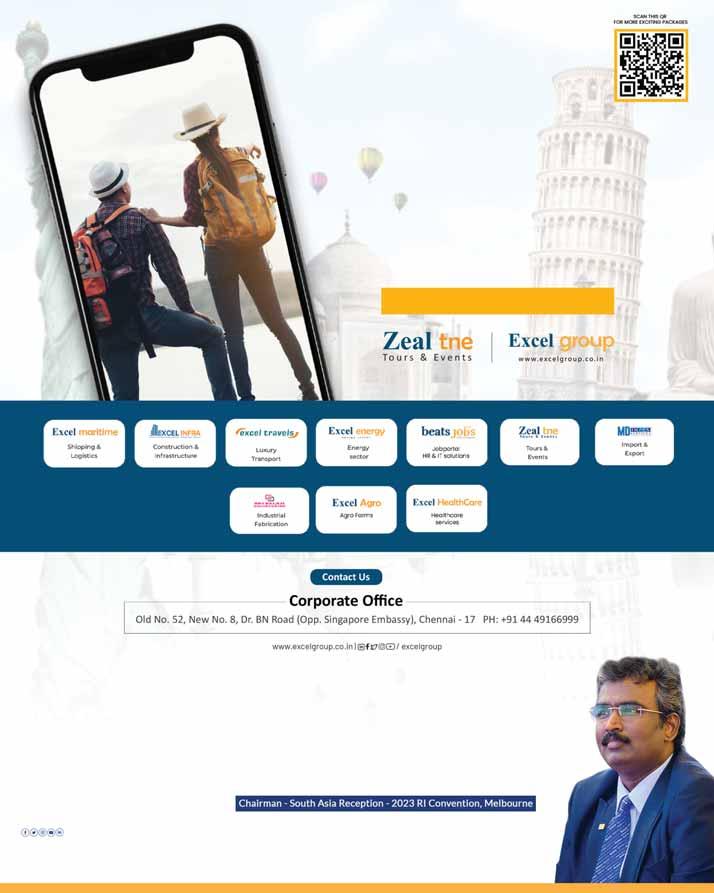
















































Thecover photo of the May issue with a group of village women at a watershed project of RC Madras Coromandel was delightful. Happy to read about this project in Krishnagiri which changed the life of the villagers there. A real-life Bajrangi Bhaijaan story is heartening and read-worthy, and the role of Rotarians is praiseworthy.
RI President Jennifer Jones’ remark that Rotary is a place where we know we are not alone is noteworthy. I am glad to know that the new Rotary year’s focus will be on mental health, as announced by RIPE Gordon R McInally.
The Editor’s note is an eyeopener to encourage and improve our services to the community. RID Mahesh Kotbagi explains well the importance of setting goals for a successful life and RID AS Venkatesh stresses the importance of retaining members in Rotary. TRF trustee chair Ian Riseley tells us how carefully the TRF funds are used in Rotary, while trustee Bharat Pandya urges Rotarians to donate liberally to the Annual Fund. The Lakshya moments photos are colourful.
The article A real-life Bajrangi Bhaijaan story throws light on an excellent humanitarian service, a role model for us. We discussed this project with other Lion clubs. Best compliments to all those involved, directly or indirectly.
Arun Kumar Lions Club of Allahabad, UP
The retention challenge
RID AS Venkatesh’s advice on retaining members is excellent and timed appropriately. Thank you, RI director,
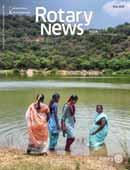
Other articles like Rotarians transform a village near Bokaro, A cinema treat for the blind in Mumbai, From Kerala to Ladakh on a Rotary Peace Mission, Egypt, the land of Pharaohs, and A community marriage for disabled couples are all informative and well-written. Many thanks for the write-up on Shankar-Jaikishan, a trailblazer in Bollywood music It is sad to read about the passing away of PDG Rekha Shetty who was one of the shining stars of Rotary as stated by PRIP Shekhar Mehta. The May issue is outstanding.
Philip Mulappone M T, RC Trivandrum Suburban — D 3211
It was a feast to the eyes and the soul to read the April issue. The
for enlightening us on this critical issue.
Mahesh Trikha RC Delhi South East — D 3011
It has been only 12 days since I joined a Rotary club. First, I took part in the RLI for two days and then became a Rotarian. Yes, retention is a big challenge in Rotary. My suggestion is that never expose a beginner like me to the Rotary Foundation. A structured framework is needed so that details
pages were studded with action photographs of beneficiaries, students learning skills and Rotarians doing projects for a better future. The issue carried articles on the various avenues of services like the Rotary Youth Exchange programme and it was really a satisfying experience going through the pages.
Congrats to the entire team working relentlessly every month to provide good reading material in Rotary News.
Radheshyam Modi RC Akola — D 3030
Please accept my sincere gratitude for the invaluable work that you are doing in keeping Rotarians around the world informed and updated about the various projects Rotary undertakes. Your dedication in sharing news and stories from the Rotary community is truly remarkable, and I am constantly inspired by the stories you publish. Rotary News is a platform for us to connect, learn from one another, and feel enlightened.
Bipan Sethi RC Ahmedgarh — D 3090
like TRF are imparted to the new members in a phased manner.
Anilkumar Naik, RC Navi Mumbai Samaritan — D 3142
The article on the fun trip to Turkey to help quake victims (April issue) is interesting. Rotarians from RID 3000 led by DG I Jerald have reached out to the quake-hit people of Turkey with timely relief material. Project chair
CR Venkatesh says in a record three days they were able to raise ` 15 lakh for the Turkey Relief Fund. Rotarians are used to helping people in distress and 125 Rotarians who went to Turkey donated the relief material to people who are in-charge of relief work. Our greetings to the large-hearted Rotarians from RID 3000.
S Muniandi RC Dindigul Fort — D 3000
Inappropriate words
The article A cinema treat for the blind in Mumbai is badly titled as it should read “for the visually-impaired, visually-challenged or visuallyhandicapped.” We are Rotarians and we should be more humane.
K Gopal Ratnam RC Madras — D 3232
I am a great admirer of your articles and editorials in the Rotary News over long. Therefore it pained me to read the words “deaf and dumb” in your May
editorial. We in Rotary run schools for the deaf and mute and take pains to educate the public that those who cannot speak are not “dumb”. Your use of these words was inappropriate.
Quresh Maskati RC Bombay North, RID 3141
I agree that the use of “deaf and dumb” was inappropriate and best avoided.
The error is regretted, and correction made in the online version.
But the word ‘blind’, when used to describe a physical condition is not derogatory. It becomes so when used metaphorically to denote ignorance, lack of awareness, such as “blind faith, blind prejudice”, etc. Hence the usage in this article was totally appropriate.
Editor
On the cover: RIPE Gordon McInally and Heather at the Lakshya meet in Kolkata. Picture by Rasheeda Bhagat.

We welcome your feedback.Write to the Editor: rotarynews@rosaonline.org; rushbhagat@gmail.com. Mail your project details, along with hi-res photos, to rotarynewsmagazine@gmail.com.
Messages on your club/district projects, information and links on zoom meetings/webinar should be sent only by e-mail to the Editor at rushbhagat@gmail.com or rotarynewsmagazine@gmail.com.
WHATSAPP MESSAGES WILL NOT BE ENTERTAINED.
Click on Rotary News Plus on our website www.rotarynewsonline.org to readabout more Rotary projects.
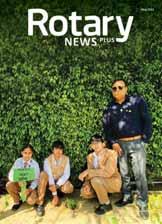
Every month we bring out the online publication ROTARY NEWS PLUS to feature your projects. This is sent to every member by e-mail by mid-month.

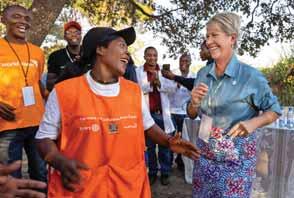
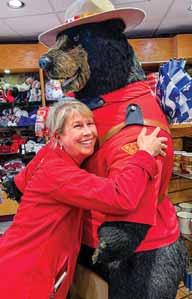
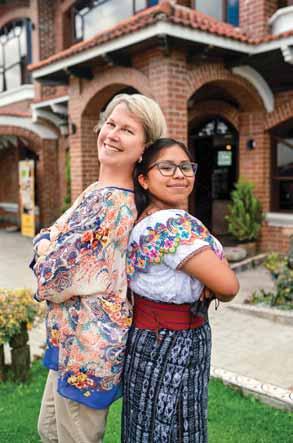
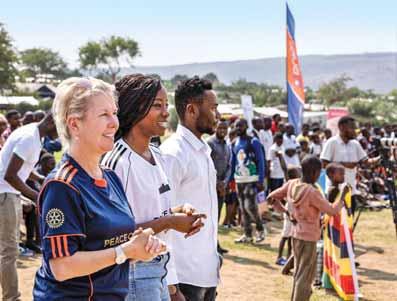
1. At the Global Citizen Festival in New York City, RI President Jennifer Jones announces that Rotary will commit an additional $150 million to the Global Polio Eradication Initiative. 2. Visiting Zambia in August, Jones talks with health workers participating in Partners for a Malaria-Free Zambia, the recipient of Rotary’s first Programs of Scale grant. 3. Jones stands shoulder-to-shoulder with Lucky Johana Mishel Chutá Simón, a student she met during a tour of the Guatemala Literacy Project. 4. In July, at a stop on her Imagine Rotary Canada Tour, Jones hugs a stuffed grizzly bear wearing the red serge tunic of the Royal Canadian Mounted Police. 5. Jones and actor Sibongile Mlambo (centre) have fun at a soccer game at the Nakivale refugee settlement in Uganda.
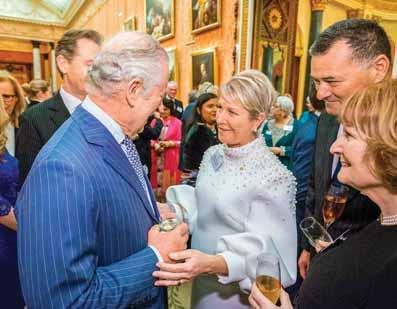
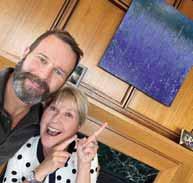
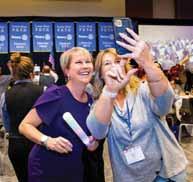
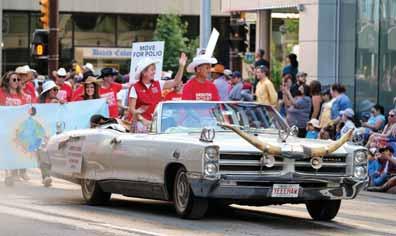
6. Accompanied (at right) by her husband, Nick Krayacich, and Judith Diment, dean of the Rotary Representative Network, Jones greets King Charles III in London on Commonwealth Day. 7. During an Imagine Impact Tour stop in Taiwan, Jones and her husband enjoy a quiet moment while seated in a cabbage patch. 8. Jones with her brother, Darren, whose painting Imagine One’s Dream inspired her presidential tie and scarf. 9. Jones poses for a photo at a seminar in Texas for Rotary club presidents-elect. 10. Jones and Krayacich ride tall in the saddle at the annual Calgary Stampede Parade in Alberta.

Speaking to you through the pages of Rotary magazine this past year has brought me so much joy. I have especially enjoyed sharing the incredible stories of the wonderful people Nick and I have met on the Imagine Impact Tour.
From Patzún in the mountainous western highlands of Guatemala to a small village outside of Lusaka, Zambia, we have been greeted by countless people who imagine and work toward a better world.
We were inspired by teachers who imagine a better education for girls and boys facing gender-based violence, by Rotaractors in a refugee settlement who created a flour mill to provide for their families in a critical food shortage, and by brave polio workers who push tirelessly to reach every last child.
All of us have imagined Rotary this year. This means looking past what we are today and reaching for what we could be tomorrow. We imagine a Rotary that will continue to tell our stories in impactful ways, work to reduce our carbon footprint, and focus on diversity, equity, and inclusion efforts that lift every voice in our organisation and beyond.
Nick and I want to thank all of you for the moments we’ve shared and for your efforts to Imagine Rotary. And now, we look forward to continuing these efforts as we Create Hope in the World. It has been an honour and a privilege to serve with each of you.
Jennifer Jones President, Rotary
International


Phone: 044 42145666 e-mail: rotarynews@rosaonline.org
Rotary at a glance
Rotary clubs :37,075
Rotaract clubs :11,263
Interact clubs :13,151
RCCs :12,843
Rotary members: 1,202,506
Rotaract members:175,906
Interact members:302,473
As on May 16, 2023

Throughout our lives, from school, through college, attending sermons in the places of worship we frequent according to our faith, we are taught to be good and courteous, indulge in appropriate behaviour, and so on. In short, we are trained to conform… to societal norms. Hence the article titled A club for the Cancelled in The New Yorker magazine made me sit up. Here, every month, over 200 media professionals, academia, and other intellectuals are invited in New York to what is called the Gathering of Thought Criminals! The only qualifying factor — you have to be socially ostracised, broken rules, lost a job, friends, etc for holding unpopular opinions. Some people on the guest list are notorious: élite professors who have broken university rules, journalists who have made a name for themselves amid public backlash, or nobodies who have defied societal norms.
Initiated by Pamela Paresky, a PhD from the University of Chicago, and lovingly referred to as the ‘Mother hen of the cancelled,’ the thought criminals meet once a month and talk about how many of them are misfits. One attendee ranted about how left-leaning New York has become and almost “every conversation is about how capitalism is evil or how America is the most racist, sexist, homophobic country in the world.”
It’s a long article which talks about “political homelessness” and other issues which set me wondering about how the place for dissent and nonconformist views is shrinking in our world, including our own country. But imagine how dull and boring our lives
will become if everybody falls in line, obeys all the rules, good or bad, right or wrong, because people in authority say so; be it in a school, college, workplace, religious organisation, political party or government. If that happens, how will new and different thinking, innovations, disruptive businesses — such as Airbnb or Uber — come in? If the system, your organisation, your loved ones, or government, lulls or steers people towards a state of mind where you accept everything without questioning, rejecting or doubting, then what is left of the human mind? It’s very convenient for the ruling dispensations to label those who ask question as “urban naxals,” or “environmental terrorists”. But just look at the disasters that happened by not hearing their questions or heeding their warnings, be it in Kerala, so often devastated by floods, or Joshimath in Uttarakhand, both due to haphazard and dangerous construction activities in ecologically sensitive zones.
This is at the community level, but even at a personal level, if we conform to accepted norms all the time, fall in line always, both at the workplace and the home, surely something within us shrivels up, and you diminish as an individual, worst of all, in your own eyes.
Quite often there is merit in standing up, speaking out, standing apart… it requires courage, but is worth it in the long run. We might not make it to Pamela Paresky’s gatherings, but we’re bound to make a difference, somewhere… somehow… and to someone.
Rasheeda Bhagat
RID 2981
RID 2982
RID 3000
RID 3011
RID 3012
RID 3020
RID 3030
RID 3040
RID 3053
RID 3054
RID 3060
RID 3070
RID 3080
RID 3090
RID 3100
RID 3110
RID 3120
RID 3131
RID 3132
RID 3141
RID 3142
RID 3150
RID 3160
RID 3170
RID 3181
RID 3182
RID 3190
RID 3201
RID 3203
RID 3204
RID 3211
RID 3212
RID 3231
RID 3232
RID 3240
RID 3250
RID 3261
RID 3262
RID 3291
Selvanathan V Saravanan P
I Jerald
Ashok Kantoor
Dr Lalit Khanna
Bhaskar Ram V
Dr Anand A Jhunjhunuwala
Jinendra Jain
Rajesh Kumar Chura
Dr Balwant S Chirana
Shrikant Balkrishna Indani
Dr Dushyant Choudhary
Kalta VP
Gulbahar Singh Retole
Dinesh Kumar Sharma
Pawan Agarwal
Anil Agarwal

Dr Anil Lalchand Parmar
Rukmesh Pannalalji Jakhotiya
Sandip Agarwalla
Kailash Jethani
Talla Raja Sekhar Reddy
Vommina Naga Satish Babu
Venkatesh H Deshpande
N Prakash Karanth
Dr Jayagowri Hadigal
Jeetendra Aneja
Rajmohan Nair S
B Elangkumaran
VV Pramod Nayanar
K Babumon
Muthu VR
Palani JKN
Dr. Nandakumar N
Kushanava Pabi
Sanjeev Kumar Thakur
Shashank Rastogi
Pravudutta Subudhi
Ajoy Kumar Law
Printedandpublishedby ,15
Sivaswamy Street, Mylapore, Chennai 600004, on behalf of Rotary News Trust and printed at Rasi Graphics Pvt Ltd, 40, Peters Road, Royapettah,Chennai600 014, India, and published at Rotary News Trust, Dugar Towers, 3rd Floor, 34, MarshallsRoad,Egmore,Chennai600008.
Editor:
The views expressed by contributors are not necessarily those of the Editor or Trustees of Rotary News Trust (RNT) or RI. No liability can be accepted for any loss arising from editorial or advertisement content. Contributions are welcome but will be edited. Content can be reproduced with permission and attributedtoRNT.


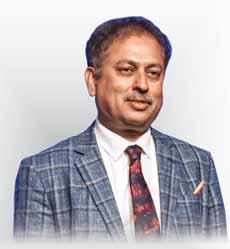
Iam deeply grateful for the opportunity to work as a Rotary director. It’s been an honour to serve as a conductor, harmonising our members’ voices and abilities into a symphony of service to bring constructive change in the community. Visiting various districts across India and overseas, I came across different ideas in terms of several service projects, saw the dedication and devotion of Rotarians, and how Rotary functions in different corners of the world.
The hard work put at the grassroots level by clubs in zones 4, 5, 6 and 7 is commendable. We are Number 1 in membership growth and service projects, and Number 2 in TRF-giving.
During my tenure we focused on empowering girls and women. Instead of donations, our focus was on capacity-building to change lives for good. Project Operation Imagine changed the lives of thousands of women and girls. We should focus on sustainable environment, highlighting Rotary projects in the Northeast, and use of local languages for 100 per cent literacy.
I thank those who supported me, took care of me as special aides, and collaborated to make my service as director gratifying and enjoyable. My deepest thanks to my colleagues on the Board, TRF trustees and the
RI and RISAO staff. I thank Rotary News editor and staff, regional leaders and RI officers, for providing us with a forum to communicate, exchange ideas and celebrate our successes. Each contact, meeting and event has provided me with the chance to experience Rotarians’ extraordinary devotion and selflessness.
I have a collection of photographs and videos, and uncountable memories from my visits to over 20 countries. My responsibility as a director is over, but my role as a Rotarian continues forever.
As I hand over the baton to my successor, I am filled with optimism for the future of Rotary. With visionary leaders at the helm, I see a vibrant organisation that will continue to evolve to meet the changing needs of our world. On behalf of my family, I thank Rotary for welcoming us with open arms and making us feel a part of a wider, loving community.
As I bid adieu, let’s keep the Rotary spirit burning bright and our hearts filled with joy.

Mahesh Kotbagi RI Director, 2021–23
As I sit down to pen my last piece as a director of Rotary International, the first thought that comes to my mind is that “time flies”! It has been a thoroughly enjoyable journey where I learnt a lot. I had the opportunity to travel the length and breadth of our country, interacting with thousands of Rotarians, listening to them, enthused by their passion and amazed at their commitment. I thank everyone for the warmth and generous hospitality showered on Vinita and me in every part of the country.

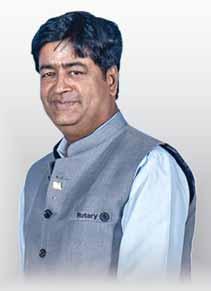
AS VenkateshRID 3232
Dr Mahesh KotbagiRID 3131
Dr Bharat PandyaRID 3141
Rajendra K SabooRID 3080
Kalyan BanerjeeRID 3060
Shekhar Mehta RID 3291
Ashok Mahajan RID 3141
PT Prabhakar RID 3232
Dr Manoj D DesaiRID 3060
C BaskerRID 3000
Kamal SanghviRID 3250
Gulam A VahanvatyRID 3141
Anirudha Roychowdhury RID 3291
There is no doubt that Rotary in our region is robust, healthy and on a positive growth trajectory. The Rotarians in our region rose up to the call given by our president and imagined highly impactful community service activities that made a difference to the community that we live in, and worked tirelessly to make those dreams come true.
The leadership at every level demonstrated a great deal of commitment. Each one trying to do better than the other in a healthy way. However, we cannot rest on our laurels. We need to work on areas that can be done better. There are a few thoughts that come to my mind.
Firstly, we can, at every level, look beyond a year when we plan our projects. Though most offices are only a year long, the community
that we serve will benefit a lot more with large projects that are sustainable and highly impactful, but may not be completed in a year.
Next, sustainable membership growth, and not just addition of numbers, has to be our focus. This will keep us healthy in the long run. The efforts in this direction has to be broad-based with the active involvement of every member of the club. This will ensure greater retention.
Lastly, let us create an environment where all Rotarians are knowledgeable about the good work done by The Rotary Foundation, so that they may spread the word and also contribute themselves. Let everyone feel it is their Foundation.
I am hopeful about the future. My wishes to every Rotarian as you strive in your own way to Create Hope in the World!
Sayonara! Au revoir! Auf wiedersehen! Until we meet again…

TN Subramanian RID 3141
Executive Committee Members (2022–23)
Dr Dushyant ChoudharyRID 3070
Venkatesh H DeshpandeRID 3170
Dr N Nandakumar RID 3232
Dinesh Kumar Sharma RID 3100
Editor
Rasheeda Bhagat Deputy Editor Jaishree Padmanabhan
Administration and Advertisement Manager Vishwanathan K
Rotary News Trust 3rd Floor, Dugar Towers, 34 Marshalls Road, Egmore Chennai 600 008, India. Phone: 044 42145666 rotarynews@rosaonline.org www.rotarynewsonline.org

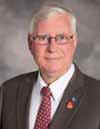
marks the end of one chapter and the beginning of another in Rotary, a bittersweet time to reflect as we look ahead.
Looking back on this year, The Rotary Foundation accomplished a great deal. We renewed our determination to fight polio to the end. Rotary and its partners in the Global Polio Eradication Initiative are implementing a strategy to stop the transmission of all wild poliovirus in the endemic countries of Pakistan and Afghanistan and the circulation of vaccine-derived poliovirus in outbreak countries. Last October, Rotary, the Bill & Melinda Gates Foundation, and the global community collectively pledged $2.6 billion toward this plan.
We know what it takes to eradicate polio, and we have the strategies to do it. I urge all clubs to continue to take action in this historic effort by raising awareness and funds, especially around World Polio Day in October. Also, consider joining or starting a PolioPlus Society in your club or district to collectively give a set amount each year until polio is eradicated.
Our Foundation also responded to the devastating earthquake that hit Syria and Turkey through disaster response grants that helped clubs and districts provide aid.
The Foundation continued to grow. Rotaract clubs began volunteering on and applying for Foundation grants on their own. And our next Rotary Peace Center, made possible by a gift from the Otto and Fran Walter Foundation, will be
To all who supported The Rotary Foundation by volunteering on grant projects or through giving, I thank you. If you haven’t yet made your gift to the Foundation, please do so online by 30 June so we can end this remarkable year on a high note and reach our goal of raising $430 million.
We can be proud of what we have done this year, but let us never rest on our laurels; rather, let us remain persistent. One of those who best personified persistence was Nelson Mandela. Speaking to a crowd of global dignitaries before his 90th birthday in 2008, he said, “It is in your hands to make of our world a better one for all, especially the poor, vulnerable, and marginalised.” Changing the world is indeed in no one else’s hands but our own, and helping those in need is what defines and will continue to define Rotary and its Foundation in the years ahead.
I wish incoming Trustee chair Barry Rassin, the trustees, and our staff continued success in making a difference through The Rotary Foundation.
Ian H S Riseley Foundation Trustee
Chair
RIDE Anirudha Roy Chowdhury and his spouse Shipra with (from L) RID 3232 PDG Babu Peram, RID 2982 PDG C Sivagnanaselvam, RID 3231 DGE P Bharanidharan, PDG Chandra Bob and RID 3203 PDG EK Sagadhevan at the PETS meet. DGN M Rajanbabu is seen standing fourth from left.
DGE P Bharanidharan conducted the PETS of RID 3231 in Chennai, which was presided over by incoming director Anirudha Roy Chowdhury. Apart from his wife Shipra, the event, in
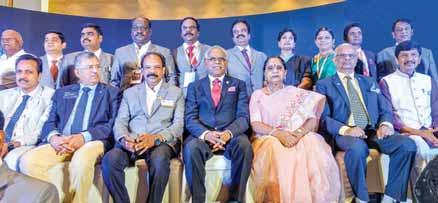
which 82 of the 96 club presidents of the district underwent training, was attended by RID 3232 PDG Abirami Ramanathan, PDGs EK Sagadhevan (3203), M Muruganandam (3000), C Sivagnanaselvam (2982), DGE Ravi Raman (3232) and DGN NS Saravanan (3232). TS Ravikumar, past president of RC Arakkonam, was the PETS chair.
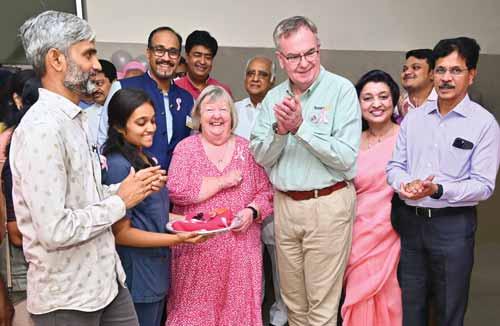
RIPE Gordon McInally and Heather inaugurate the digital mammography equipment at the Royapettah Hospital, Chennai, in the presence of (from L) Dr Gopinath, HOD, Radiology department, RAC Saveetha Medical College president Meenakshi Periakaruppan, DG N Nandakumar, RID AS Venkatesh, PDG Abirami Ramanathan and RC Madras T Nagar president Meenakshi Periakaruppan.
We are overwhelmed to see the incredible projects that you are doing. Every service project that we have visited so far reiterates the hope Rotary is giving communities through Rotarians like you. TRF is the engine that provides the energy to do good in the world. But the fuel to run the engine is you and your wonderful projects,” said RIPE Gordon McInally, during his visit to Chennai, where he inaugurated a series of projects. He was accompanied by his wife Heather. A digital mammography machine was inaugurated by McInally at the Government Royapettah Hospital for cancer cure. It was a project of RC Madras T Nagar and PDG Abirami
Ramanathan, having contributed `46 lakh, was its major contributor. Club president Meenakshi Periakaruppan is his daughter, and granddaughter, also named Meenakshi Periakaruppan, is the president of RAC Saveetha Medical College which is also a partner in this $57,000 global grant project. RC Makati Jose P Rizal, RID 3830, Philippines, is the international partner.
RI Director AS Venkatesh complimented the partnership of Rotary and Rotaract and thanked the Ramanathan family for their generosity. “It is important for Rotary to make healthcare accessible and affordable to all, irrespective of their economic or geographic divide,” he said.
RID 3232 has installed 146 dialysis machines last year. “This year we will be setting up 70 more machines across the city, in partnership with the Tanker Foundation, Wockhardt and Chennai Corporation. We will be supporting 40 people for organ transplant through a GG,” said DG N Nandakumar.
The incoming president soft launched a dialysis centre set up by RC Chennai Upscale in a PHC. The GG project is worth $112,632. Referring to the club president Nilesh Kumar Singh’s introduction of his club and its “humble” achievements, McInally said, “Never be shy to tell people about your achievements because it is only by doing so you inspire others to do more.”
He launched an app and website, rotarydialysis.com, developed by RC Madras Industrial City to identify Rotary dialysis centres that offer free services across Chennai. The website uses live location and gives information on where the facilities are located, distance and contact details.
RC Madras has constructed 66 toilets and handwash stations in two schools — the Saraswati Vidyalaya Primary and Higher Secondary Schools — in Karaikudi, 430km from Chennai. The schools with a combined strength of 2,200 pupils are in their centenary year. DGND and AKS member Vinod Saraogi, Mohan Raman and PDG J Sridhar had initiated the project which cost `52 lakh ($72,000). AKS member Vijayabharathi Rangarajan contributed $15,000 as Directed Gifts for the project. A mammogram facility installed by the club at a PHC in Devakottai, a rural pocket in TN, was also inaugurated virtually by McInally. “The facility is a boon in this region. Earlier women had to travel 200km to the nearest town, Madurai, for breast cancer screening. The travel costs about `800 ($10), which is way too high for the villagers,” said club president Jayashree Sridhar.
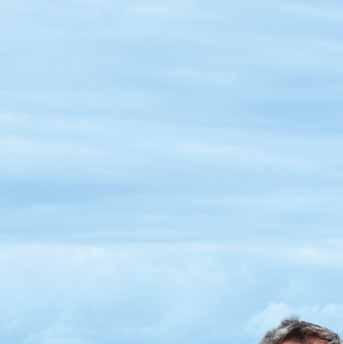
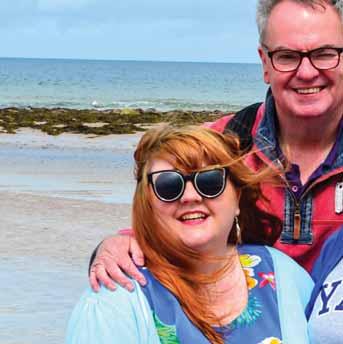
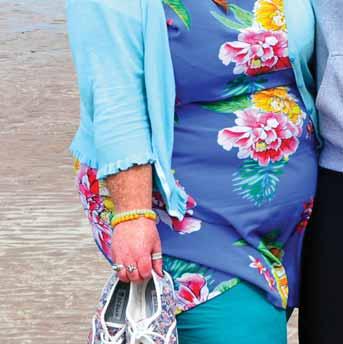

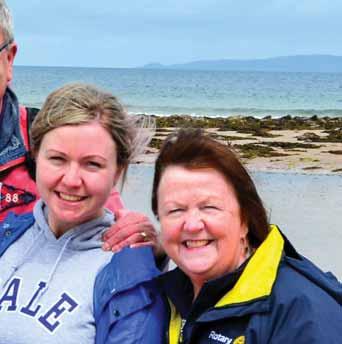
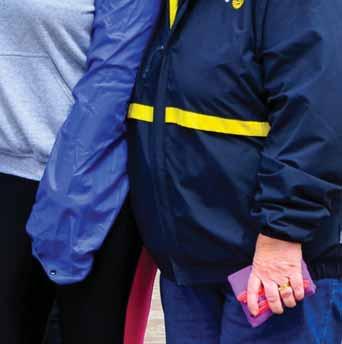



IRasheeda Bhagat

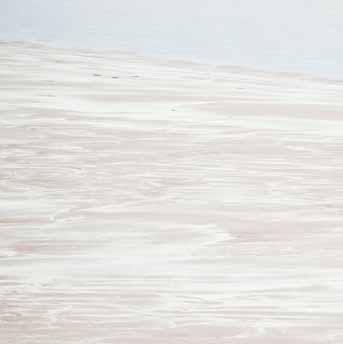
don’t want to be patronising when I talk about the rank-and-file Rotarians in India, because we are all rank-and-file Rotarians, but the passion and pride among the Rotarians in the clubs is simply energising. I have been in India during the last three days; In Chennai, Madurai and now Kolkata… and will be going to Nagpur, Ahmedabad and Mumbai. To witness that passion and pride is fantastic!”
I catch up with incoming RI president Gordon McInally and his spouse Heather at the Lakshya event in the ‘city of joy’. They are fun to talk to and appear totally at home… whether it is Heather donning the colourful yellow silk saree or Gordon sporting the purple kurta and crooning away on the stage and later dancing to Bollywood music
along with the Rotarians. Spicy Indian food? No problem, he simply loves it.
But make no mistake about it; the extremely articulate incoming RI president is a straight shooter; he doesn’t mince his words, but you also know those words come straight from the heart. Like when he says, “Rotary is as much about what’s in your heart, as in your pocket!”
No stranger to Rotary in India, over the years he has closely followed it “in the magazines and over the social media. I know that Rotary is so vibrant here, there is so much passion and pride among the members.” He talks enthusiastically about the new Rotary club he had chartered only the previous night in Chennai… “with 97 charter members! That could be a record. We say there should be 20 members to charter a club. Director Venky says

I am a Christian, and have strong faith, so yes, I am religious.
I love food, particularly Indian food. I do not find it spicy. The Indian food here is different from what we get in Scotland. But the Indian food in Scotland is good. As you can probably tell, from my size, I love all foods!
Oh, I like cooking, I like preparing food. (Heather, when asked about his best preparation: “I’d say a lot of different things because Gordon does something that I don’t do — take a recipe and stick to it. Whereas I improvise. But he will do it exactly how it should be done and its good.”)
I like all sorts of music. (Laughs). I do like opera and musical theatre. I lean towards the classical music side of things.
I don’t get much time to watch movies these days. Somebody asked me what is your favourite movie and I said ! That should tell you how much of
movies I watch! (Heather: Mine is
so that’s as bad!) I’m not a big movie watcher because of the time it takes to watch a movie. If I want to fall asleep, I’ll watch a movie!
I like reading fiction, thrillers, particularly medical fiction. I am a big fan of Patricia Cornwell, Kathy Reichs.
I enjoy reading the classics, Robert Louis Stevenson from Scotland of course. and , I love those books.
I want to see a more peaceful world.
A world where people are more tolerant. I want to dedicate this presidency to our two granddaughters and all the children of this world in the hope that we can make this world a better place in which they can grow and thrive. And that comes in many ways, just as you said about hope… hope can be interpreted in many ways. We are actually the same; the conflicts in the world are
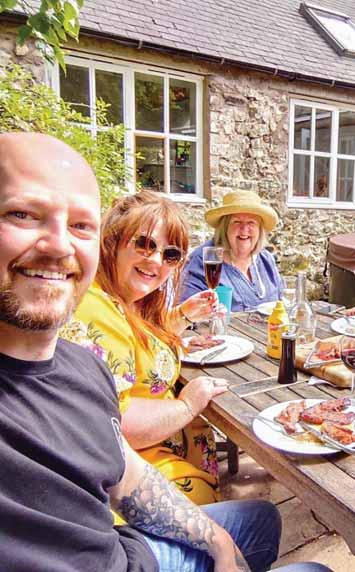
started by governments. If we can just get people to respect and talk to each other, there would be much less conflict in the world.
This is a measure of how much and why Rotary is needed by the world today. Conflict is a representative of disunity and we have a global network that is united.
The world has never been more split and polarised. We have polarisation in countries but Rotary can bring people together and that’s why we need the strength of Rotary in places like India as all over the world, to be that uniting force and make things better for people. Can you just imagine, if Rotary didn’t exist in India, or anywhere else, including my country… what a hole there would
From L: Son-in-law Greg, daughter Rebecca, Heather, granddaughter Ivy, daughter Sarah and Gordon.
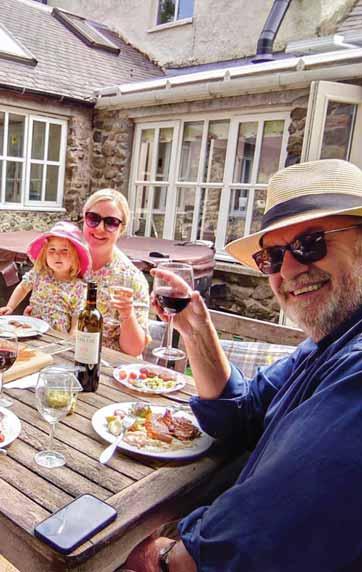
be, in terms of the social good we do.
By changing people’s perception of Rotary, and telling them what we are really all about. And making Rotary available to all, changing the style of clubs, and bringing in flexibility in when and how often we meet. All these things make it easier to join Rotary. I believe that to be
a qualified Rotarian has as much to do with what’s in your heart as what’s in your pocket! Rotary has to be available to everyone everywhere, in a style that suits all… whether it is going to a lavish club for a 2–3-hour lunch or dinner, or a brief get together followed by project work. That’s what Rotary is about, the work, and not the meeting. That’s how we are going to attract the younger generation.
in India you like having 40 to charter a club. But to have 97 charter members, and all of them doctors, and available as a resource for other clubs to do medical projects, is amazing. And you’re leading the world in channelising CSR funds for service.”
But, as always, added the president-elect, “there is an elephant in the room, and that elephant is the politics. And that makes me sad because if we could eliminate some of the politics, then India would be an even brighter shining beacon in Rotary. I am not going to tell you that I have an answer to that. It has to come from within.”
Striking a candid note, McInally said: “The number of election disputes and complaints that come to the RI Board out of India way outnumber any other part of the Rotary world and that sometimes colours Rotary’s world
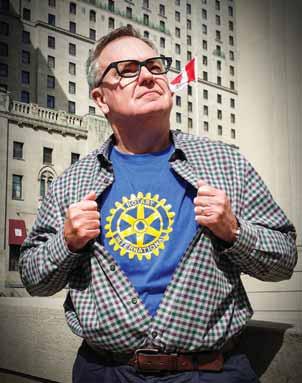
judgement and view on India. I’ve seen a different side of it because I am interested in what happens in India, and you certainly are creating hope in the world.”
That is of course his presidential theme and we move to why he selected it. “Over many years I had seen Rotary giving hope to people who were at their absolutely lowest, as the woman in Thailand who had lost everything in the tsunami (of 2004)… her husband, children and her home. She told me she had lost everything, including hope. But Rotary gave her hope by giving her a new home.” To express her gratitude, she gave him a shell. “That shell has been in my home for 15 years, reminding me of that woman and how Rotary gave her hope.”
Similarly Rotary has given hope to innumerable people; he had personally seen it in Africa; in Rwanda
where he had worked with the children after the genocide, as also to the 4-yearold girl in Manila whose heart was mended through a Rotary project. While watching that surgery, his
phone buzzed, and he later saw it was a picture of his smiling 4-year-old granddaughter ready for her first day at school. “I was happy because that little girl at the operating table had
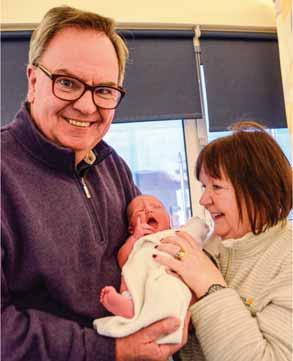

also been given hope by Rotary to live a similar life to my granddaughter… go to school, get an education and be happy. People can lose a lot, but if they get to the stage where they lose
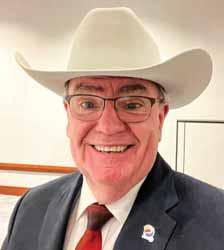
We have to get away from the single year mentality… the ego of the president. Nice though it is to be received at airports with garlands, I can see that it often gets into some people’s heads.
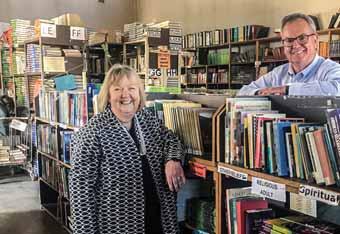

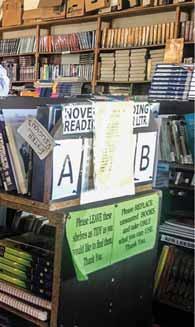
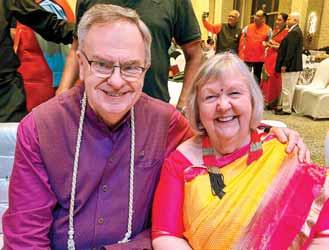
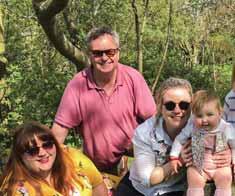



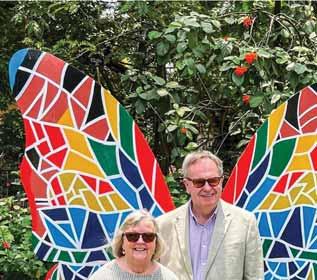
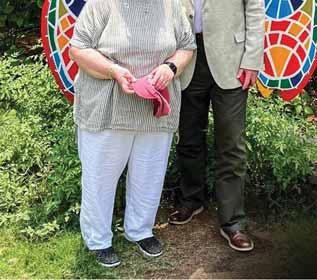
hope, they’ve come to the very bottom. So this theme is more than words… it’s a call to action.”
Coming to his Rotary journey, McInally joined RC South Queensferry, Scotland, in 1984, when he was only 26, relatively newly married to Heather, who he “met through music. Heather is a professional opera singer and we met in our late teens.
At the Biodiversity Park in the Bombay University.
We both graduated and then got married in 1980.” The couple shifted just outside of Edinburgh, and through their church met a farmer who was a Rotarian. He invited them first for a social event and then Gordon to two Rotary meetings. “I enjoyed these, not realising that I was being groomed for membership!”
He was the youngest member of the club and remained so for a few years; “now, 39 years later, I am probably one of the five youngest members of the
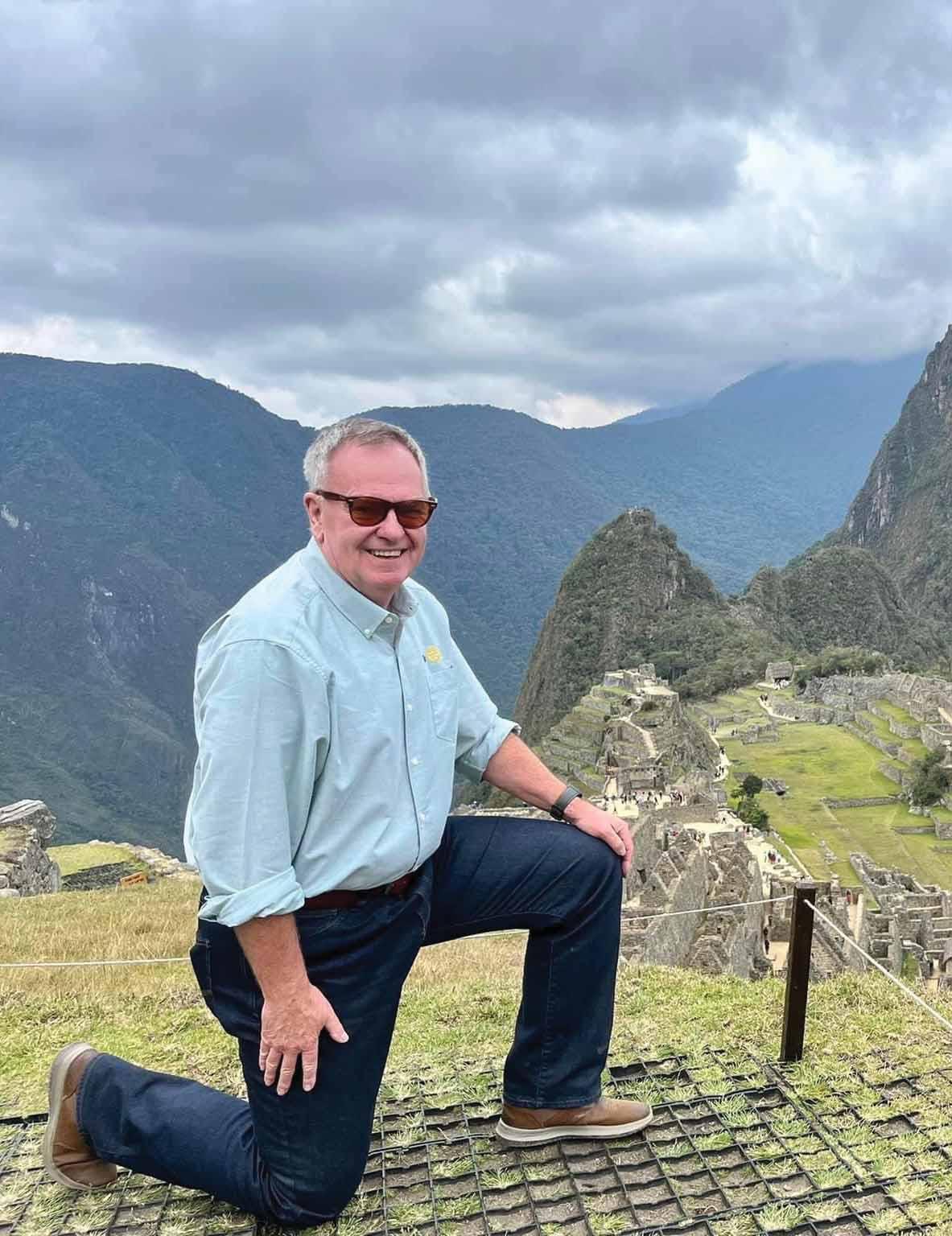

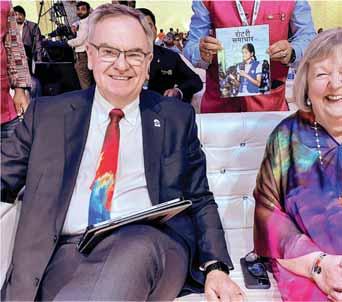

The elephant in the room is the politics. That makes me sad because if we could eliminate some of the politics, then India would be an even brighter shining beacon in Rotary.
people who are united, have the same mind, and could do things together to make the world a better place. It is one thing to make your village a better place but if you have the potential to make the world a better place, then how much better is that!”
These thoughts flashed across the young dentist’s mind and he was convinced that through Rotary he could leave a meaningful impact on other parts of the world as well.
club. The whole club has aged and that is the challenge that Rotary faces, in my part of the world in particular,” he admits.
He remained just “a member of a Rotary club, like so many others, till something happens to make you a Rotarian!” In his case, it was within a year of his joining, when he heard PRIP Bill Huntley from England speak. “He was a wonderful speaker who spoke about his Rotary journey and what Rotary was achieving beyond the club, district and the zone. I remember thinking that day that I get this… I know what this is all about! It is not just about local or even national issues. This is a worldwide network of
McInally became president of his club at 33, governor at 39, RIBI (Rotary International in Great Britain and Ireland) president at 46 and an RI director at 49. He served on the Board along with Ashok Mahajan from 2007–09. Then he took a bit of rest to “get my business affairs in order. To be perfectly honest, I never saw Rotary as a career path, I’ve always made myself available to do jobs when needed. I’ve chaired the Toronto convention and the operations review committee. And then, as I suspect happens to a lot of people, some of the
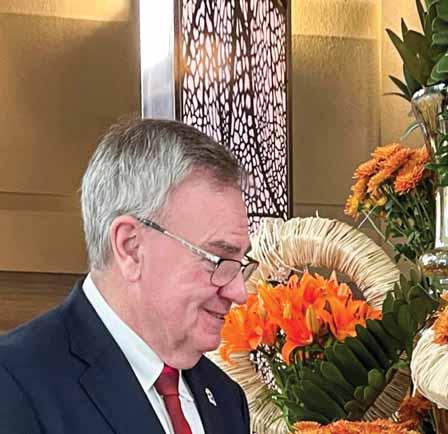
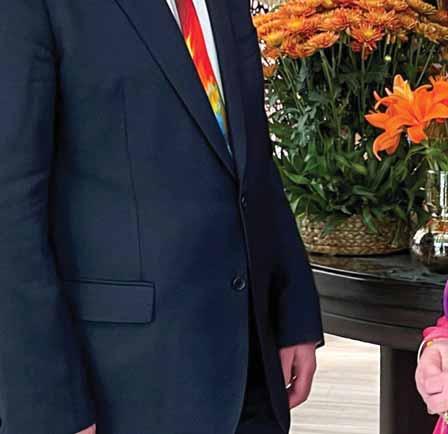

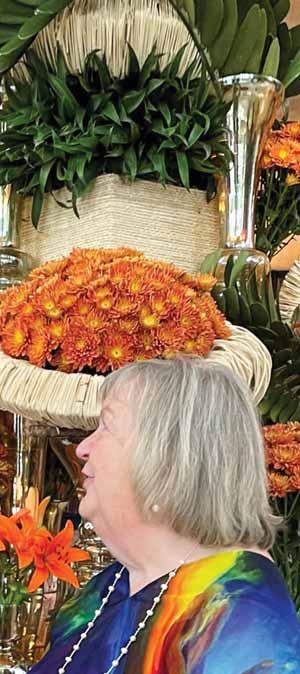
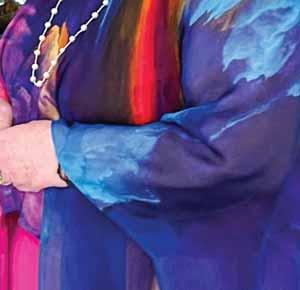
Iask Heather, the spouse of RIPE McInally, whether she felt proud or worried that her husband’s nomination as president-nominee would infringe so much more on his time. “Oh no, that’s never worried me because the family has been so involved in Rotary all our lives. Gordon was in Rotary before our elder daughter was born. So that’s never been a problem.”
But yes, one concern was their having to be away from the granddaughters. “This was clearly a little bit of a problem, but Covid changed all of us because it brought us all to Zoom. And during Covid we would be reading our granddaughters bedtime stories over Zoom.” The visual medium now allowed them to spend even more time with the grandchildren. “Believe me, they are always in touch, asking where are you now, can you send us pictures.”
On her husband’s achievement she says, with a twinkle in her eye: “I was proud, I still am; but don’t let him know that! The Scot in me says that I will never let him know how proud I am of him. But one thing is certain; we have always worked together all our lives in everything, whether it is Rotary or other things. I know what his thought process is and he knows what my thought process is, so we discussed it. And I was told very clearly before he put his name in, that if you don’t want it, I won’t do it!”.
McInally intervenes to emphasise the important role a Rotary spouse plays when the partner takes on a leadership position. “I’ve said this before, if you have a partner, you need her support. Stephanie, who is going to be president, doesn’t have a partner which tells us that you do not need to have a partner to be the president of RI. But I think at any leadership level in Rotary, be it a governor, director or president, if you have a partner, you need her/his support.”
So what has Heather’s support meant to him? “Oh, it means a lot. As she says we are a team but we are always independent; my job is my job and her job is her job. Often, we don’t see each other the whole day, most nights we are together but not every night. So from that point of view, we’re not unused to being on our own.”
At this point, Heather delivers a clear winner. “I’d like to use the expression we don’t live in each other’s pockets, but we always come home to be under the same roof at night.”
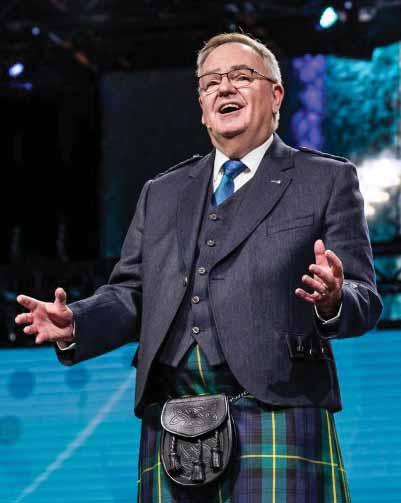
past presidents and other senior leaders tap you on the shoulder and say “Have you considered standing for president? And that’s what happened to me.”
Asked if he would give some time to his work, he shakes his head resolutely: “Not now. You can’t have a practice and do this… it is a full-time job! I had already decided to step back from full-time practice.”
So how did Heather receive the idea? “Well, she has been a Rotarian for 20 years, and president of not one, but two different clubs, so she’s one up on me!” quips McInally. “But we’ve always been a team, and when an opportunity comes up, we sit together and do an analysis. This time too we went into our standard conclave to decide whether I could bring anything to the table. We decided maybe I could and so here we are!”
The couple has two daughters, “who have grown up in Rotary,” but they were relatively young as he took up the role of a governor, RIBI president and RI director. “That wasn’t easy, but we were fortunate as they had very supportive grandparents, who took care of them
Ishow RIPE Gordon McInally the April cover story of , featuring RID 3212’s flagship project to empower girls from smaller towns and villages of Tamil Nadu. “This is fascinating,” McInally responds. “But we are now beginning to transition our language about ‘empowering’ girls. I think it is patronising to say that I am going to empower you. I’d rather say I am going to help you to unlock the potential that is already there. So instead of empowering girls, let’s say ‘girls’ empowerment’. It might be a play on words but I think it’s an important distinction. It is not that we are giving power to you. You already have that power; we are going to help you unlock it. If we can lift up girls and women folk, then we can make inroads into virtually everything.”
On DEI and there being seven female governors from
India on his team, he says it is significant. But the following year, the number reverts to one, I point out. McInally says, “But that is going to happen, partially because of the way we select governors. Past governors select incoming governors and historically most of the past governors are male.” But he makes it clear that any dialogue should be about ‘Rotarians’ and not ‘women Rotarians’; because that usage would “make women a subclass. I am not described as a man Rotarian but Heather is called a woman Rotarian. She pays the same dues as me, she does a lot of work for Rotary. So she too should be known as a Rotarian.”
People can lose a lot, but if they get to the stage where they lose hope, they’ve come to the very bottom.
But he concedes, that “we need to still talk about it. All I ask is that we get the right and best qualified people for the job. That’s why I am glad that Jennifer (Jones), who I have known for long, is the president this year and Stephanie (Urchick) will be president the next year. I know they are there because they were the best people available for that job, and not because they are women. And any woman would want that. She wouldn’t want to get the job simply because she was a woman but because she was the best for the job.”
when we had to be away.” Striking a poignant note, the incoming Rotary leader says: ‘Our one regret is that none of our parents are still alive. It would have been so nice to share this moment with them.”
On his priorities as RI president, McInally emphasises the importance of continuity. “You are never going to change the world in a year. When I was club president, governor and director, I spoke about this; we have to get away from the single year mentality… particularly the ego of the president. Nice though it is to be received at airports with garlands, I can see that it often gets into some people’s heads and they begin to believe their own publicity.”
But the fact is that “we are all Rotarians. I happen to be doing a job; this year the job I am doing is taking me away from the reason I joined Rotary, which was to be a member of my club. And work for it. So I’d like to get away from the mentality that it’s MY year. It is one of Rotary’s years and Rotary has been around for 118 years and it’ll be around for many, many more years.”

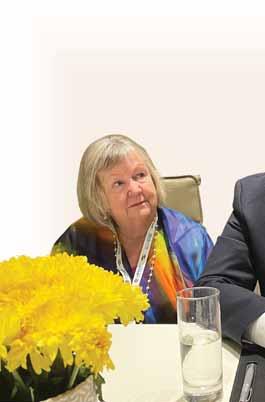


from anxiety or depression. From there it can get worse. So we need to open up the conversation, destigmatise it and remove the taboo. The challenges are very different in different areas.”
On the possibility of the world becoming polio-free during his year, McInally stops me and says: “It’s not MY year; it’s a Rotary year, but I know what you mean. Yes, we Rotarians think about it all the time.
The WHO believes that by the end of this year we would have hopefully seen the last case of wild poliovirus infection. It is wonderful to think that we could see the last case of polio this year. But it’s not about me being the president when it happens but the fact that it will happen.”

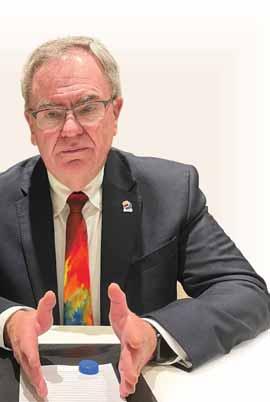
Can you just imagine, if Rotary didn’t exist in India, or anywhere else, including my country… what a hole there would be, in terms of the social work we do.
On the next big Rotary initiative after polio is done and dusted, the incoming president smiles and says: “You’ve probably asked this question to other senior leaders before, and will get the same answer. We don’t want to think about anything else until polio is done. But, from a strictly personal point of view, I question whether we should or not rush into another global project on the same scale.” He is very happy with TRF’s new Programs of Scale — in Zambia and Nigeria. This could be a model for the future too.
The new initiative that he is promoting this year is on mental health. “The world at this moment is in a very bad place as far as mental health is concerned, particularly because of Covid, and for far too long this has been a taboo subject. There is a stigma around it and people don’t want to say that they are suffering
“From a very personal point, I’d love to see the mental health initiative become a long-term global project. I know it can’t be a 12-month project, and can say without breaching any confidence that Stephanie is very keen to continue it.”
Pictures by Rasheeda Bhagat and special arrangement
Designed by Krishna Pratheesh S
Kiran Zehra
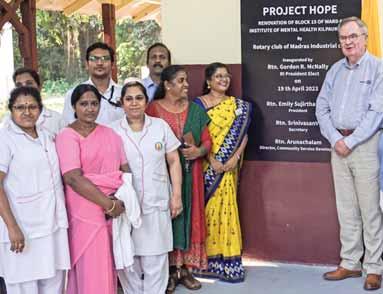
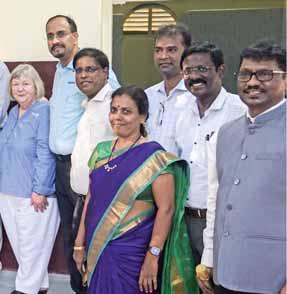
RIPE Gordon McInally and Heather after inaugurating the renovated ward at IMH, Chennai, in the presence of DG N Nandakumar, PDG J Sridhar, RC Chennai Industrial City president Emily Titus, club members and hospital staff.
An 800-metre stroll through a tranquil path beneath a green thicket of towering trees and colourful flowering plants, accompanied by the calming chirp of birds from the main block of the Institute of Mental Health (IMH) in Kilpauk, Chennai, leads to Block 15, a refuge for nearly 100 mentally challenged patients. The building got a much-needed facelift through Project Hope, an initiative of RC Chennai Industrial City, RID 3232. From a total budget of $112,000 (`93.5 lakh), the club has, in the first phase, renovated Ward 6 at a cost of $12,050 (`10.24 lakh).
RIPE Gordon McInally, who inaugurated the new block in the presence of RID AS Venkatesh and DG N Nandakumar, reiterated the importance of tackling mental health issues and destigmatising it. “Mental
health awareness is a cause close to my heart and I urge our clubs to identify specific needs of the local community and engage in mental health projects,” he said.
Block 15 treats patients with severe mental illnesses like schizophrenia, bipolar and personality disorder. It is one of the 21 wards at IMH, which also houses facilities for de-addiction, mentally-ill prisoners, an intensive psychiatric care ward, geriatric ward, and six special wards for children and adolescents.
IMH director Dr M Malaiappan said, “We get around 500 patients a day. This highlights the importance of the Institute’s role in addressing the community’s mental health needs. However, many of our facilities, including Block 15, were outdated and in dire need of renovation.”
The renovation activity included repairing damaged floors and walls, replacing outdated furniture and equipment, and construction of a toilet block. A wide platform and a ramp leading to it have also been constructed in the garden. This will be used for therapeutic intervention, including yoga and exercise, group therapy sessions and individual counselling. Staff nurse R Lakshmi pointed out that the improved lighting and ventilation will benefit the patients’ overall health.
“Our aim was to provide a safe, comfortable and calming environment for the patients,” said PDG and club member J Sridhar. Club president Emily Titus is happy that “the club’s contribution has created a more conducive environment for healing and recovery for the inmates.”






Dream big… don’t worry where the money will come from, and don’t worry about failure. Because if you don’t dream at all, you will not fail. Just like you won’t reach your destination if you don’t even leave your home! If you want to see the biggest failures in the world, google the failures of Abraham Lincoln. He failed in almost everything he tried and yet he is one of the most successful people in history.”
With these words past RI president Shekhar Mehta urged the governorselect and DGNs assembled at the Lakshya goal-setting event organised by incoming RI director Anirudha Roy Chowdhury in Kolkata recently.
While the International Assembly and GETS were important landmark events in the DGEs’ journey as they approached their year as governors, “Lakshya, the goal-setting event that you are now attending under the chairmanship of PDG EK Sagadhevan, is no less important. I would call this one of the most important events in a DG’s journey, because after IA and GETS, it
From L: PDG HR Ananth, Lakshya chairman PDG EK Sagadhevan, PRIP Shekhar Mehta, RIDEs Anirudha Roy Chowdhury and TN Subramanian, and PDG
Rajendra Rai, after releasing the Workbook for District Governors and Regional Leaders at the Lakshya programme in Kolkata.
is here that you finalise your vision and set your goals for next year.”
Urging the participants to keep “sharp focus” on the discussions they had with the coordinators and assistant coordinators at Lakshya, who would give them “guidance without interference,” Mehta said on July 1, they all would be on a roller coaster. “Here you will see the highs of your life, its thrilling and exhilarating moments, as also the low moments.”
Quoting the Indian coach for women’s hockey team, played by Shah Rukh Khan in the iconic film Chak de India,
who tells the hockey players before their World Cup final match, Mehta said: “In that movie Shah Rukh tells them that the 70 minutes of that match would be the most important minutes of their life. Similarly, I would say that the 366 days (2024 is a leap year) of the coming Rotary year will be the most exciting, most precious days of your life. How you use them will be crucial. Use this unique opportunity to do community service to your heart’s content, because you won’t get these days back.”
Giving an example of the “amazing work” that zones 4, 5, 6 and 7 do, the
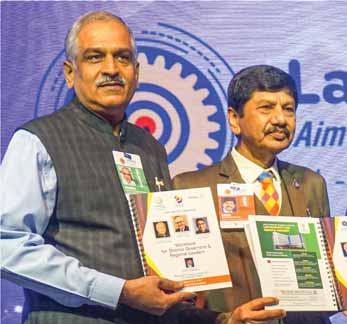


past president said that last year, thanks to these four zones putting in exemplary work in getting new members, for the first time in a long while, Rotary’s declining membership had been arrested. Even in TRF giving, “you have been No 2, now you cannot slide down to No 3.”
When it comes to doing service projects, Rotarians in our zones, India, Nepal, Sri Lanka and Bhutan, have no comparison. “I don’t have to tell you how to do projects; I’ve been going to several PETS, and learning from you how to do projects.”
His only advice to them was to dream big; “what bigger dream can be there than the one to eradicate polio?
A dream that required so many countries to work together. This is an organisation that has a larger footprint and presence in more countries than even the UN. And who can dream bigger than Rotary governors?”
Appealing to them to look at the larger picture, Mehta said, “In the next one year you will change millions of lives. In that year, thanks to you, thousands of children will get heart surgery, tens of thousands of people will be able to see once again, and hundreds and hundreds of villages will have potable water only because of you. This is the power you have… please think of this as god’s work.”
Similarly, thousands will be able to afford dialysis because of the facilities they set up. He gave examples of the big service projects that had resulted thanks to the ambitious goals set up at Lakshya two years ago, and even earlier, as Rotary celebrated its 100th year in India. Once again, it was at a Lakshya meeting that Mehta’s own district (3291) had pledged the building of a 500-bed hospital in Kolkata costing `400 crore, and the then DGE
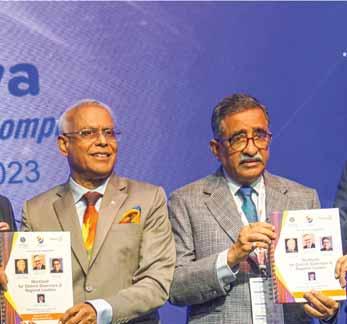
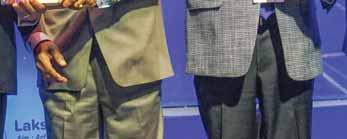

This is an organisation that has a larger footprint and presence in more countries than even the UN. And who can dream bigger than Rotary governors?
Sameer Hariani had pledged that his district alone would do projects worth `800 crores.
But the breakout of the Covid pandemic put a brake on the realisation of those lofty goals in the following year. However, with the pandemic “now behind us, we’ve laid the foundation stone for a 500-bed, `400 crorehospital barely 5km from where we are seated (West End Hotel in Kolkata). We’ve also laid the foundation for a ` 300 crore-residential school for 1,000 tribal girls where they will get free boarding and education. All these projects began with big dreams.”
But the craziest dream of them all “was the one Rotarians in India dreamt, after we were declared polio-free; to make India totally literate. Only if you get into the literacy programme, you will understand its enormity. After all, in 75 years of Independence, all that the Indian government has managed is 75 per cent literacy. And here are a handful of us thinking we will make India 97 per cent literate by 2027, and totally literate by 2030,” added Mehta.
But he cautioned the Lakshya participants, “It doesn’t happen just by dreaming… you have to put in a lot of detailed planning, collective effort and hard work… that’s the magic of Rotary. One person dreams; a true leader is a dealer in hope, and everybody works to fulfill that hope, that dream.”
To achieve these ambitious goals, they’d have to think that they were working not for Rotary, “but your country. So go for big projects; if you think the project is too big for your club, partner with 20 other clubs, districts and even other countries. Think up dreams so big that they can’t be completed in your year and have to be carried forward.”
Listing out some big goals that were achieved, Mehta said that last year the target was to put up 125 dialysis machines all over India. (P)DG J Sridhar, from one district (3232), alone put up 135 dialysis machines; 15 eye hospitals were put up with the help of DGE Hiralal Yadav (RID 3291).
Also, while setting up big goals, they should not worry about the money. As RI president he had visited 40 countries and promised help
As RI president, I went to 40 countries, to each of them Rotary had something to give and nothing to ask.
Isn’t that amazing?
to so many heads of state, particularly in Africa, for heart surgeries. He had no concrete plan how these promises would be fulfilled. But when requests for heart operations came in, DGs and PDGs, such as Rajendra Rai, Rajendra Agarwal, Sandip Agarwalla etc, had risen to the occasion to get these done.
“So resolve today that we want to do a health camp for 10 lakh people,
set up so many blood banks… I doubt any other organisation in India has put up as many blood banks as Rotary has done. If there is no blood bank in 100 sqkm around you, then put up one. If there is no eye hospital within a distance of 50km, put up one. Every DG/ DGE has some strength, work with each other’s strengths. For setting up dialysis machines take Sridhar’s help, for eye hospitals contact Hiralal Yadav, and for general hospitals PDG Sagadhevan. He constructed in 45 days a 70,000 sqft hospital with 400 beds (in Erode).”
His last words on the power they held as incoming governors in Rotary: “As RI president, I went to 40 countries, to each of them Rotary had something to give and nothing to ask. Isn’t that amazing?”
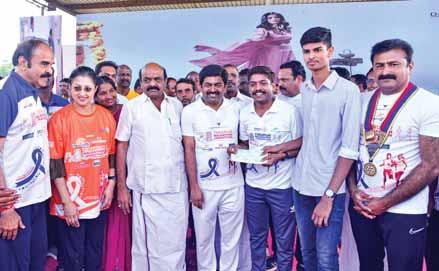
Rotary clubs of Tirupur, RID 3203, have come together to establish a cancer care centre at the Tirupur Government Medical College and Hospital. The `90crore project, headed by PDG Dr BA Muruganathan, will be executed jointly with the Tamil Nadu government, with the latter contributing `60 crore. RID 3203 will contribute `30 crore.
A fundraiser marathon and walkathon, hosted recently for the cause by RC Tirupur Gandhinagar, drew a participation of 15,000 people, including DG B Elangkumaran, other past governors and district leaders.It helped raise `85 lakh directly and `1.5 crore in the form of donations.
Around 2,000 Rotarians from RIDs 2981, 2982, 3000, 3203 and 3212 had an opportunity to interact with RIPE Gordon McInally at the Rotary Leadership Conclave held in Madurai, Tamil Nadu, during his visit to India. He urged the delegates to draw inspiration from Mahatma Gandhi, whom he considered his “most favourite leader,” and demonstrate empathy, stewardship and a commitment to the personal growth of others.
McInally announced that service projects worth $400 million will be implemented in the upcoming Rotary year through The Rotary Foundation,
with specific global focus on service projects related to mental health and empowerment of girls and women.
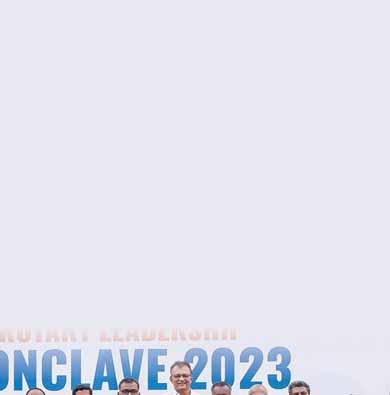
Conclave convener RID AS Venkatesh highlighted the immense potential for Rotary’s growth in India, and encouraged members to actively participate in club activities. By enhancing the Rotary experience for members, attrition can be prevented and “Rotary can continue to spread its positive impact on communities.”
McInally’s visit to India signified the scope for Rotary’s transformative work in the country, said PRID C Basker. The country’s huge population and the strength of its youth power
can play a pivotal role for Rotary’s growth in India.
Conclave chairman PDG M Muruganandam briefed the incoming leader about Rotary’s work, particularly by the participating districts in the region. As RPIC for Rotary year 2023–26, he reassured his commitment to promoting Rotary’s public image on a larger scale.
Earlier, McInally and Heather were given a traditional welcome, as they were driven on a horse-drawn chariot, and treated to cultural dances and music of the region.
DG V Selvanathan, DGE G Senguttuvan, DGND J Leone of RID 2981; DG P Saravanan, DGE S Raghavan, DGN V Sivakumar, DGND Sivasundaram of RID 2982; DG I Jerald, DGE R Anandtha Jothi, DGN R Raja Govindasamy, DGND J Karthik of 3000; DGE Dr S Sundararajan of RID 3203 and DGE R Muthiah Pillai of RID 3212, along with their respective district college of governors, honoured the international leader.
RIPE Gordon McInally and Heather with (seated, from L) DGE Muthiah Pillai, PDG B Arumugapandian, RID AS Venkatesh, PDG M Muruganandam, his wife Sumathi, PRID C Basker and PDG Chinnadurai Abdullah at the Rotary Leadership Conclave in Madurai.
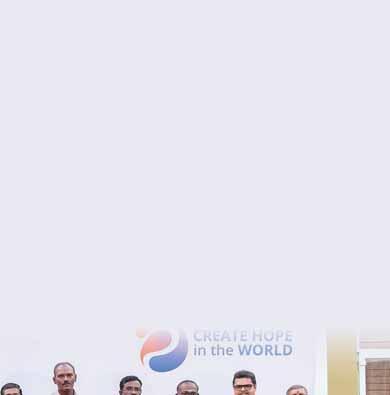
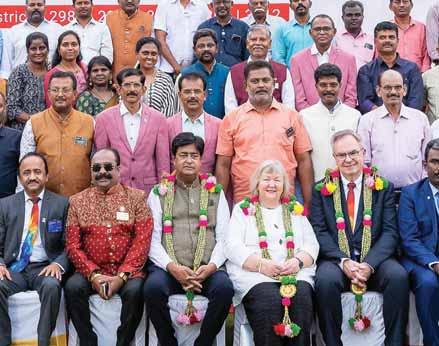
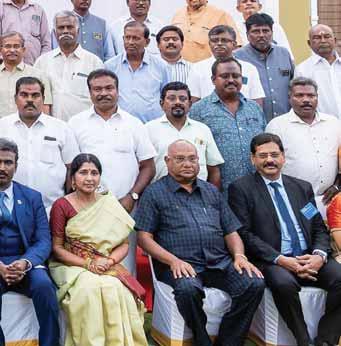

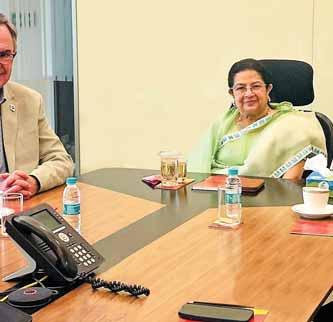


Heather, RIPE Gordon McInally, PRID Ashok Mahajan and RIDE T N Subramanian with Rajashree Birla, chairperson, Aditya Birla Centre for Community Initiatives and Rural Development.
Below: RIPE McInally and Heather with PRID Ashok Mahajan, TRF trustee Bharat Pandya, RIDE Subramanian, his wife Vidhya (right), DG Sandip Agarwalla, his wife Malini, and past governors of RID 3141. DGN Chetan Desai and DGE Arun Bhargava are seen on the left.
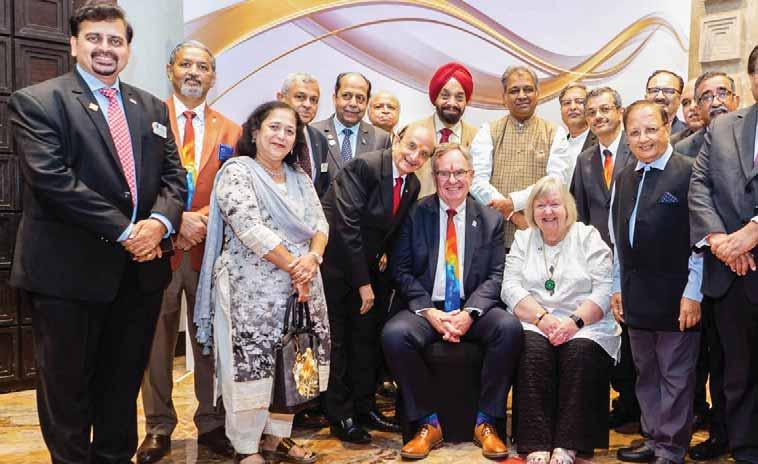
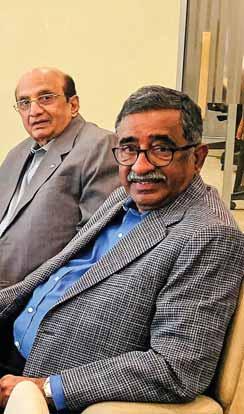
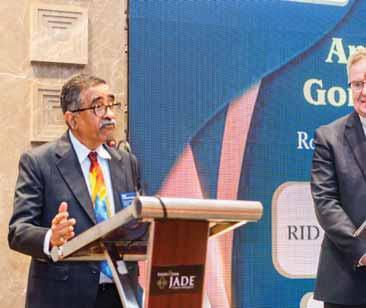

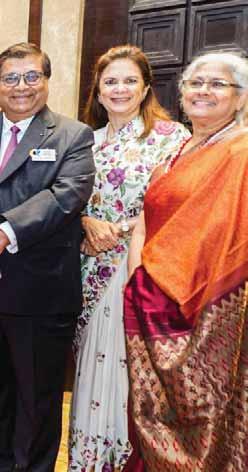
In Mumbai, RIPE Gordon McInally and his spouse Heather attended an event organised by RI Districts 3141, 3142, 3131, 3132, and 3170. Attended by DGs, DGEs, club presidents and district officers, the event was planned and executed by RIDE TN Subramanian.
RI director Mahesh Kotbagi and TRF trustee Bharat Pandya addressed the gathering, and briefed the incoming RI president about Rotary’s work in India, particularly these districts, and the governors showcased the work they had done during the year.
Addressing the meet RIPE McInally explained to the assembled Rotarians, the relevance of Rotary in today’s world, and the need to create hope in the world. He also gave them details of the good work Rotarians have done around the world to provide succour and hope to those facing severe
hardships. His address received a standing ovation from the gathering.
A highlight of RIPE McInally’s Mumbai visit was his meeting with chairperson of the Aditya Birla Centre for Community Initiatives and Rural Development Rajashree Birla at her office, during which he expressed his gratitude on behalf of Rotary International for her Foundation’s generous donation to Rotary for the cause of polio eradication. She assured him of her continued support to Rotary in its endeavour to create hope in the world and make it a better place.
Also present at the tea meeting, organised by PRID Ashok Mahajan, were Heather McInally, Pandya and RIDE Subramanian.
McInally and Heather were also hosted a private dinner in Mumbai by Mahajan, who was his batchmate on the RI Board.
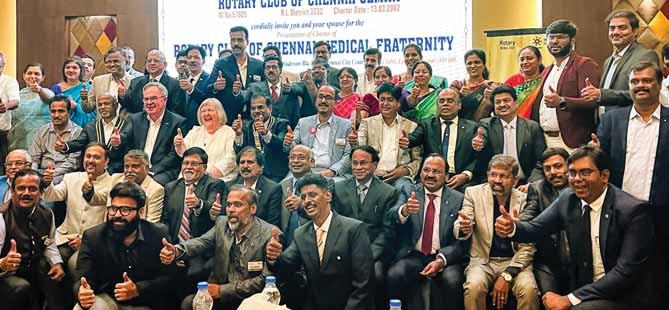
Gordon McInally and Heather, RC Chennai Gemini president Dr Ezhilarasan, DG
Venkatesh, PDG ISAK Nazar and DGN Mahaveer Bothra, along
Fraternity. PDG Babu Peram and new club president Dr S Muthukumar
It is heartwarming to see this huge gathering of doctors who want to volunteer their services to the community through Rotary. A big ‘thank you’ to each one of you. I am sure you will have the best experience of your life and feel you have made the right choice in joining Rotary to do good in the world,” said RIPE Gordon McInally, welcoming the 97 green members of the newly-formed RC Chennai Medical Fraternity, during his visit to Chennai. All members of the new club, sponsored by RC Chennai Gemini, RID 3232, are either doctors, hospital owners or administrators. McInally handed over the charter to the new club president Dr S Muthukumar, orthopaedic surgeon and chairman of a Chennai hospital.
“The birth of a new Rotary club is like the birth of a child in our family. As a Rotary family, we celebrate the
birth of every new club. Membership is the lifeblood of our organisation. I urge you to use RI’s new flexibility policy to establish new style clubs that would appeal to a different demographic,” he added.
RID A S Venkatesh complimented PDG ISAK Nazar, the district membership councillor, for bringing doctors together to Rotary. “The opportunity of forming this kind of a club happened seven years ago. Till 2016, Rotary had a policy of not allowing more than 10 per cent of the membership from the same vocation. With relaxed norms, we now have variety including causebased clubs like RC Chennai Organ Donation sponsored by RC Madras. Promoting organ donation is its primary objective,” he said, and gave two suggestions to the new club.
“Sit together and create a fiveyear-plan that sets out the kind of
service and fellowship activities and membership profile you would like to have. Let us not think one year at a time as it restricts our ability to think big and fly high.” This approach would allow continuity. He also urged them to keep all members engaged so that they do not lose interest in Rotary. Last year alone RI lost 150,000 members. People leave not because of too much work; but if no work is assigned to them, he said. “Give them the sense of ownership. Otherwise, they will withdraw and you will not realise that till they leave Rotary.”
DG N Nandakumar recalled his visit to the new club’s meeting when he asked the new members why they wanted to be in Rotary. “While I expected a reply like I want to expand my business or want to network, what I heard surprised me. They said, ‘we want to socialise and let down our hair.
We want to do things beyond what we do as professionals.’”
During the Covid pandemic, RC Chennai Gemini had formed a WhatsApp group for over 300 doctors, including non-Rotarians, for better coordination of their services at the critical period. Later, Dr Ramesh Babu, the club’s membership chair, sent a message on the group asking those interested in Rotary to click on a link that was uploaded on the group. “When this link popped up, immediately everybody clicked on it. Doctors who are members in other
Rotary clubs for the past 20–30 years, wanted to be a member of this club too, and they were ready to pay the membership dues yet again!” But that was not possible.
He pointed out that the district had three exclusive Rotary clubs — of former Rotaractors, Round Tablers and children of Rotarians. “There are 9,000 doctors in Chennai, but we have just 100 here,” said Nandakumar, urging more doctors to join Rotary.
Muthukumar, the new club president said, “We all want to create hope in our community and our focus will be
preventive and affordable healthcare for all. You are welcome to use our club for your healthcare needs and to organise medical camps in your regions. We have doctors from all fields.”
He debunked the notion that doctors are too busy to participate in Rotary activities, and said they wanted to do more and add meaning to their lives. “I realised this when I attended a series of Rotary meetings recently. Our services are very much needed.”
RC Chennai Gemini had, earlier in Feb, sponsored a 30-member all women’s club, RC Chennai Maitreyi.
The Class 11 students of the Jamnabhai Narsee School, Vile Parle, Mumbai, raised a whopping `57 lakh in just three weeks through the crowdfunding platform, Fueladream.com
A part of the fund was used to purchase ration kits for families whose children were studying in schools in the slums of Malvani near Malad.
“The students here come from impoverished homes. For many of the families, making ends meet and providing proper food is a big challenge,” says Khuzem Sakarwala, president, RC Mumbai Bravehearts, RID 3141. This year the club has undertaken distribution of ration kits, which include 15kg rice and wheat, toor, chana and kali dals, rajma, refined oil, sugar, poha and rava, every month for the entire year to the families residing in the slums. The initiative was supported by the Jamnabhai school students in the project’s second phase.
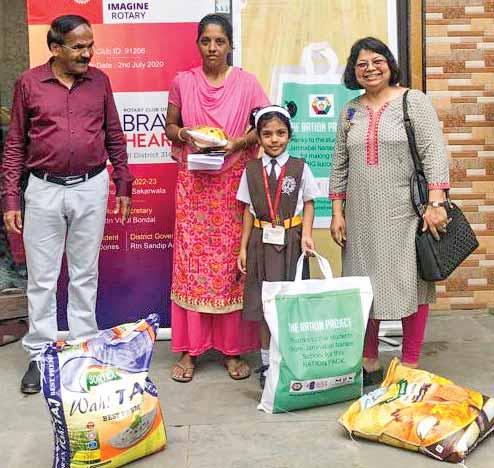
A grocery kit being given to a parent at a school in the Malvani slums.
The kits were distributed to students’ parents with the help of members of RCC Malvani Bravehearts. “Providing them with
ration kits will ensure that these children stay healthy, do not drop out of school and are attentive in class,” says Sakerwala.
V Muthukumaran
Every Rotarian must strive to drive out darkness in the world by lighting their communities with acts of love to make our planet a humane place, said RIPE Gordon McInally at a dinner meeting in Ahmedabad with over 250 Rotarians from RIDs 3053, 3054 and 3060. “We have to make love work in factories, companies, boardrooms, politics and across societies to create hope in the
world brutalised by wars, terrorism and violence despite the unprecedented progress we are seeing in science and technology,” he said.
Rotarians have an important task of becoming champions of the causes they serve and “experts suggest that acts of kindness reduce stress, and ward off depression and other mental illnesses,” he said. “I am convinced that Rotary values will deliver hope in the world and the future generations will look back at
us for our service projects.” He urged Rotarians to take pride in their work.
Putting forth his presidential focus, he said, “there are three important areas — teamwork and continuity; expanding peacebuilding initiatives; and mental health issues — which will take Rotary forward to create hope in the world.” He reiterated that “he would be standing on the shoulders of giants who had led Rotary in the past. After a seven-day tour of Chennai, Madurai, Kolkata,
From Left: DGE Asha Venugopal, DGN Rajinder Khurana, RC Nagpur North president Jyotika Kapoor, RIDEs Anirudha Roy Chowdhury, TN Subramanian, DG Anand Jhunjhunuwala, Monica, Heather and RIPE Gordon McInally at the dinner meet in Nagpur.
RIPE Gordon at the dinner meet in
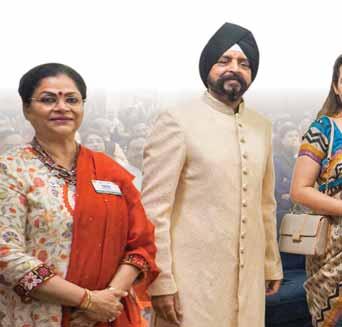
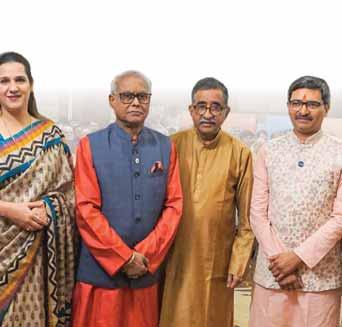


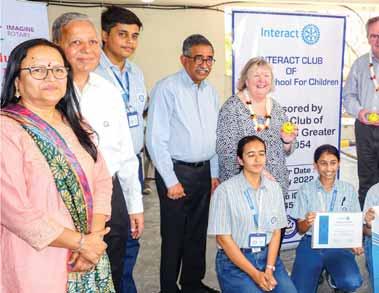
Above: From L: Bhavna Rathod, RC Ahmedabad Greater vice-president Prafful Shah, RIDE Subramanian, Heather, RIPE McInally, Rtn Manju Malaviya, club secretary Vipin Ghai, Interact chair Arup Sinha and DGE Mehul Rathod with students of the Zebar School for Children.
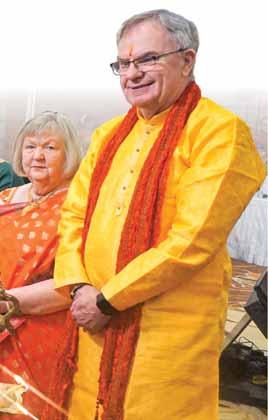

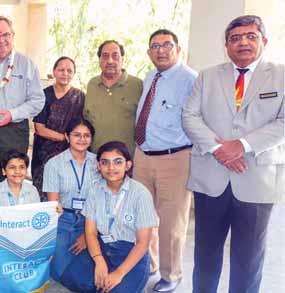
Mumbai, Nagpur and Ahmedabad, I realise that I will also be standing on the shoulders of giants of Indian Rotarians who will be serving with me together to create hope.”
Peace, a fragile construct
Earlier, addressing a gathering of 300 Rotarians from 50 clubs in RID 3030 at a dinner meet titled The Grand Gordon Show in Nagpur, he said the “horrors and ramifications of wars in Ukraine, Yemen, Syria, Afghanistan and Sudan will be felt deeply in the years to come with destruction and suffering all over the world. This only goes to prove that peace is such a fragile construct and despite scientific progress, elements like hate, nepotism, race, creed etc are thriving.” Peace and conflict resolutions constitute the basic DNA of Rotary. But the world is saddled with conflicts and “we as Rotarians must ensure that humanity thrives by spreading love so that atrocities of war and terrorism are put to an end for our children to lead a better life,” he said. Rotary is committed to peacebuilding and peace is not just the absence of war, “but more, as it is also about healthy children, education for all, providing water and sanitation, and people loving one another.”
When love takes the centrestage of human existence, “no child will go to bed hungry, justice will flow like a mighty river, we will treat each other as one big family, and above all, there will be peace in the world,” said McInally. But Rotary can’t build peace, “if there is no peace within Rotarians as we find the personal well-being of many is being challenged after the pandemic.” Social network was uprooted, and our children and young adults find their skills affected badly due to the Covid disruption. Stating that he had taken up wellness projects as a presidential initiative, he said, “Rotary clubs must build a mental healthcare system for their communities so that we have in place a number of preventive and interventionist care. We are known not only to serve the world, but also to take care of the interests and well-being of our members.” A recent study of the Ohio State University, US, showed that random acts of kindness “work against depression and elevate the mood of the people.”
During a talk show in Nagpur, RI directors-elect TN Subramanian and Anirudha Roy Chowdhury recalled their journey in Rotary, spoke about the good and bad elements in our zones; and the need to expand the Diversity, Equity
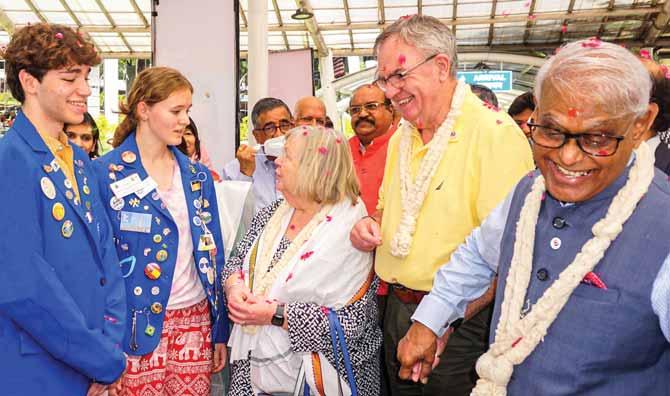
and Inclusivity principle so that more opportunities are given to women to occupy top positions. To a question from EMGA Rajiv Sharma, the talk moderator, Subramanian noted, “the letter ‘I’ and three-letter word ‘ego’ are creating conflicts in society and within Rotary. We need a change of mindset. In future, women will change the face of Rotary as service comes naturally to them.”
Chowdhury said at present 23 per cent of global Rotarians are women, and “in all the projects being showcased to McInally in Nagpur, women are at the forefront. This shows how committed they are.” Senior Rotary leadership in India should be blamed if politics is giving a bad name to the country, said Subramanian. “But Rotarians can speak their mind boldly and put forth their views,” he said. Rotary in India could not be compared with that in other countries, as Indian Rotarians do phenomenal service projects each year, said Chowdhury.
The clubs of RID 3030 are doing need-based projects across Rotary’s seven focus areas, said DG Anand Jhunjhunuwala. “Apart from running a school for special children, we have donated computer labs, set up toilet blocks and executed Happy School projects at various schools.” Two eye hospitals, two mobile eye clinics, seven dialysis centres, three global grants under execution to do 3,000 cataract surgeries, and a mammography bus to detect breast and cervical cancer are some of their projects, he said. In partnership with the Singer company and ICICI Foundation, 20 skill development centres were set up to train 2,500 people.
DRFC Mahesh Mokalkar, RID 3030, said “we are trying to make our district 100 per cent TRF-giving clubs this year and there are nine PHF clubs in RID 3030.” DGE Asha Venugopal said environment-related projects would be her priority; and “to begin with around one lakh solar lamps, lanterns and
chullahs will be distributed to tribal families; and 10 lakh aerators will be fitted into taps to conserve water.”
Thanking the RIPE for visiting Ahmedabad when “RID 3054 is going to be bifurcated next year (as RIDs 3055 and 3056),” DG Balwant Singh Chirana said, “we will be chartering RC Jaipur Trans with 25 members, an exclusive club for transgenders, thus adopting the DEI policy.” A skin bank (GG: $75,000) was set up by RC Jaipur Midtown; and dialysis centre was inaugurated at the Rajasthan Hospital through a global grant of $50,000 by RC Jaipur Roundtown.
Each member would be asked to donate at least $25 for the Annual Fund of the TRF, said DGE Mehul Rathod, charter governor of RID 3055. He would ensure that there is at least one club for a taluk in Gujarat, and at least “7–8 clubs will be chartered in Ahmedabad, with the focus on old age home and school adoption.” Ten more
mortuary vans would be added to the existing four vehicles, said DGE Nirmal Kunawat, RID 3056. With 90 clubs and 3,800 members the district leadership will do projects for women’s empowerment, water, sanitation and environment.
DGE Nihir Dave, RID 3060, listed the district’s main projects such as the eye hospital, Navsari; Rotary School, Dondaicha; drinking water and drainage facility in Surat; women’s empowerment centre, Shroff SR Rotary Institute of Chemical Technology and blood bank at Ankleshwar; diabetic care centre and skin bank at Rajkot; Haria LG Rotary Hospital at Vapi; and dialysis centres at Surendranagar, Surat, Jetpur and Dhule, and mammography and oral cancer detection vans.
RC Ahmedabad Metro showcased a Happy School at the Behrampura Municipal Gujarati School (`30 lakh) and Jaipur foot distribution to 300 amputees at a five-day camp ( ` 22 lakh). “We reinforced the roof of the school building, renovated the toilet blocks with gender segregation, built a noon meal centre, and set up a smart classroom for students up to Class 10,” said Hardik Sompura, president-elect. A giant RO unit with a water cooler was installed to provide safe drinking
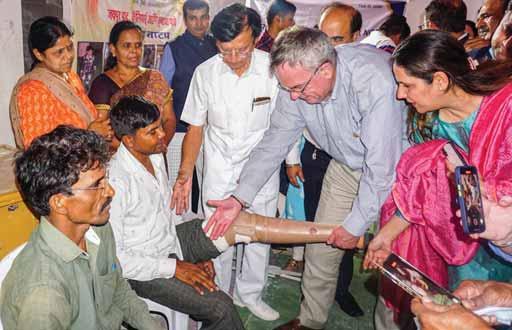
water to 790 students at the two schools on this campus. Along with Jaipur foot, callipers and crutches were given at the Shivanand Ashram. “We donated 20 wheelchairs to the beneficiaries including children with cerebral palsy and paraplegic patients,” said Atul Parikh, club president. “We have given prosthetic hands — battery-operated Inali and LN-4 hands — to over 500 people at three camps in the city.”
We have to make love work across societies to create hope in the world brutalised by wars, terrorism and violence despite the unprecedented progress we are seeing in science and technology.
Gordon McInally RI President-elect
A team of six Interactors from the Zebar School for Children, Ahmedabad, led by Rtn Manju Malaviya, Interact club advisor, briefed McInally about their projects and initiatives. “This is a ninemonth-old club with 50 Interactors who donate essentials to orphanages, teach the underprivileged children on weekends, and have raised `40,000 for projects that benefit war-torn children in Ukraine, Sudan and quake-hit Turkey and Syria,” said Arup Sinha, Interact chair, RC Ahmedabad Greater. While interacting with the students, RIDE Subramanian urged them to participate in the Rotary Youth
Exchange programmes. “A year lost in school during your RYE stint will be more than compensated by the global exposure. If required, I am ready to talk to your parents to convince them about letting you go for the YE programmes abroad.”
Projects galore in Nagpur
A three-year mental wellness project costing `25 lakh is being led Dr Rita Aggarwal from RC Nagpur in five English medium schools. The club has partnered with RC Naples, Florida, US, for the global grant project which benefitted over 2,280 students, teachers and parents during its first two phases. Nilufer Rana, president, RC Nagpur, said the club has tied up with Tirpude College of Social Work and two NGOs for the wellness project. In the third phase, trainer Rowena Philips will hold workshops for 10 months under the theme of Breakfree from Depression for 3,000 students, teachers and parents “A laser system was donated to the Swami Vivekanand Medical Mission Hospital (SVMMH) for giving free treatment to kidney
patients through a CSR grant of $21,146,” she said.
In partnership with the Mahavir International Trust, RC Nagpur North distributed the Jaipur foot to 115 amputees under Project Sahaita. “A mobile workstation goes around to take measurements and deliver custom-designed Jaipur limbs to beneficiaries. A global grant to set up our own manufacturing unit is in the pipeline,” said Jyotika Kapoor, president, RC Nagpur North.
Several medical projects were showcased by RC Nagpur Ishanya to McInally — OT equipment (`30 lakh) to SVMMH; mammogram machines at the RST Cancer Hospital ( ` 30 lakh); a pathology lab at the Matru Sewa Sangh Hospital (MSSH) for `30 lakh; surgical neuro microscope (`1.85 crore) for CIIMS Hospital; and child surgical theatre (`35 lakh) at the MSSH — all through global grants.
Over 125 people were provided surgical treatment for various minor ailments at a special camp organised by RC Dondaicha, RID 3060, in March this year. “We have been organising this camp for the past 35 years and people eagerly look forward to it to avail the services free of cost. Renowned surgeons in the locality
A year lost in school during your RYE stint will be more than compensated by the global exposure.
RIDE T N Subramanian to Interactors
“Till April, 25 paediatric surgeries were done at the new surgical unit,” said Manisha Rathi, club secretary. Among the non-global grant projects, the Ishanya club donated two dialysis machines ( ` 12.5 lakh) and a cataract equipment, Ophthalmic Phacoemulsifier ( ` 15 lakh) to
SVMMH; 50 desk-benches and 250 white canes to the Blind School; and 60 public toilets are being run by the club with funds from the Nagpur Municipal Corporation and Brahmos Aerospace.
A Covid ICU (GG: `40 lakh) which treated 400 patients was converted into a cardiac ICU at the SVMMH by RC Nagpur Vision. Club president Shivani Sule, an eye surgeon, said, “a haemodialysis centre with three machines, RO units and 6KV solar panel (`30 lakh) was set up at the Sant Govindram Sahib Hospital.” The club has applied for a GG worth `30 lakh for donating a biomedical waste disposal unit for a 100-bed hospital. Regular medical and surgical camps for the State Reserve Police and surgical camps for tribal communities are also organised.
Pictures by V Muthukumaran

participate in the camp every year,” says club president Dr Praful B Dugad. Prior to the camp, a primary medical camp was organised to identify people suffering from small to medium lipomas, cysts and corns to be treated at the camp. Eight surgeons performed the surgeries and the entire cost including follow-up
consultations, post-surgery dressing, stitch removal and medicines were borne by the club.
DG Shrikant Indani who visited the camp appreciated the club for its efforts and the meticulous planning done by club members Dr B L Jain and Dr Omprakash Agarwal for the success of the camp.
Team Rotary News
To promote wellbeing and a healthy lifestyle among the elderly, RC Pune Pride, RID 3131, conducted a walk and jog event titled Ageless Wonders for senior citizens in partnership with Simple Steps, an NGO founded by Guinness World Record holder Ashish Kasodekar. His aim is to promote running across all age groups.
The event started with a warm-up exercise and Zumba dance to the tune of popular Bollywood music at the Pune University. With over 500 registrations and
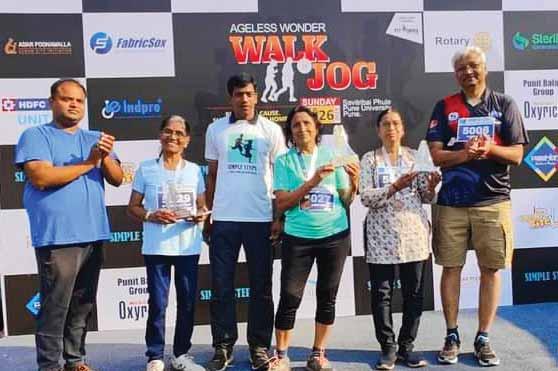
members from laughter clubs, the participants were charged up to go.
Dr Hema, spouse of DG Anil Parmar, along with Pune’s Ironman Dashrath
DG Anil Parmar (second from R) and Dr Hema with RC Pune Pride president Ujwal Kele (right), past president Subodh Malpani (left) and DGND Santosh Marathe.
With over 500 registrations and members from laughter clubs, the participants were charged up to go.
and Marathe

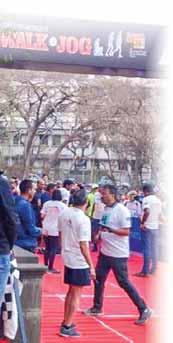
Jadhav, first flagged off the 10km run. It was followed by the 5km run, and finally the 3km group.
All the finishers were given a medal. “The joy on the faces of senior citizens after they received the medals showed that we have achieved our objective of the event, that is, making the elders realise ‘yes, we can also do it,’” said Sudhir Bapat, president-elect (2023–24), RC Pune Pride.

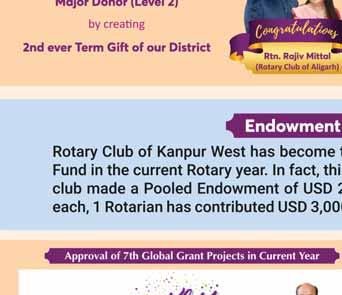
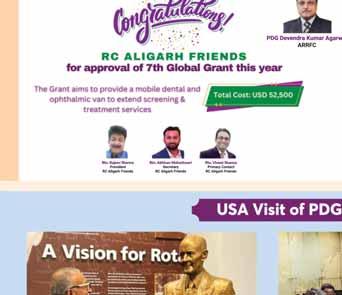
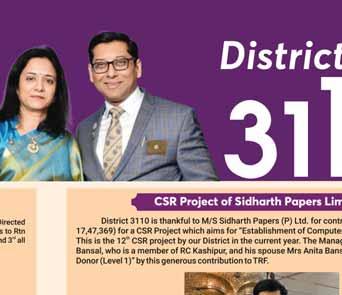
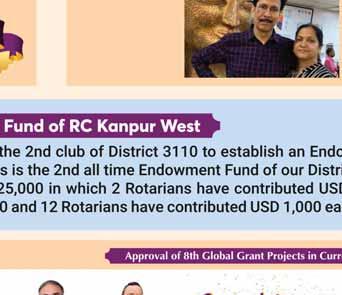
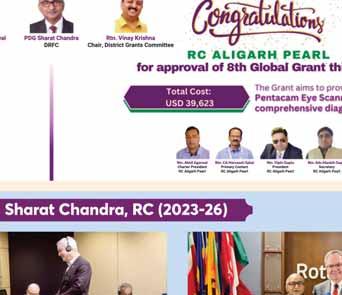

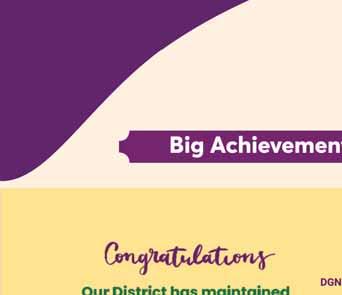
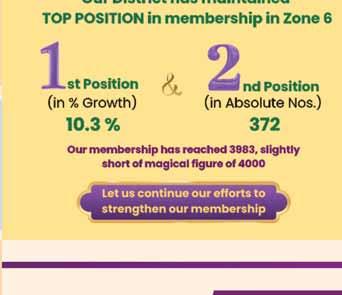
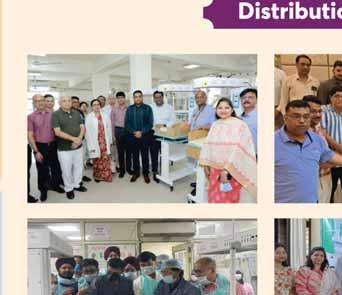
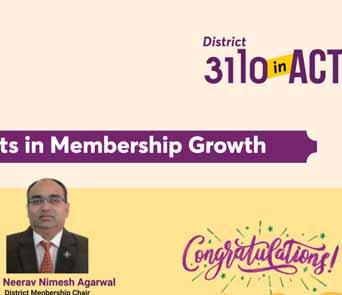
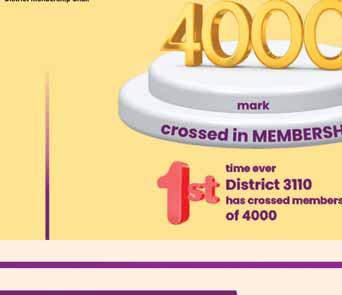



Here is an impressive story of four transgenders who started their new journey from learning to sew to becoming fashion designers, all thanks to RC Calcutta Presidency, RID 3291.
Two years ago, Ranjita Sinha, a transwoman, introduced 10 transgenders to the club to be trained in tailoring to help provide them a livelihood.
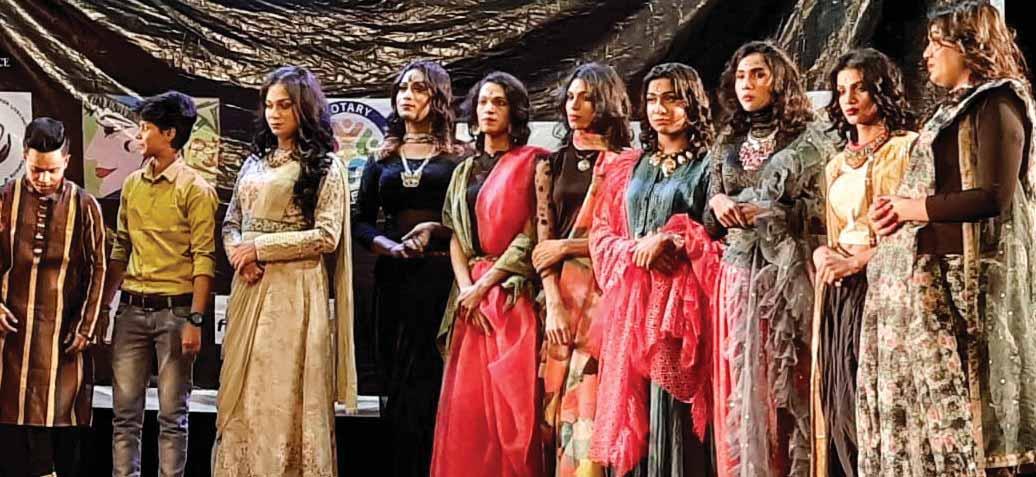
The club’s protégés Ayaan, Rayan, Debanjan and
“We engaged a teacher to take classes twice a week and equipped a government centre with four sewing machines and accessories. The material required for practising was given by a fabric boutique, Geeta’s Circle,” said club president Rina Malpani.
After the completion of basic classes, the club engaged a fashion design expert Dipanwita who took four of them under her wing and taught them to create designer wear.
Enthused by the students’ progress, “last December we planned a fashion show with the theme ‘Ardhanarishwar’, a composite form of Hindu deities Shiva and Parvati. We encouraged our students to design the costumes in line with the theme,” said Rina. The dresses were ready in a month and the club gave them a stipend for their work.
Ranjita, through her Instagram page, invited transgender models, makeup artists, photographers and choreographers to audition for the show. Sponsors were roped in and the ICCR Centre, Kolkata, was booked for the event. After hours of gruelling practice in choreography and catwalk, and dress rehearsals, the models put up a grand show on D-day.
DG Ajoy Kumar Law, Hindustan Aeronautics director
Pranab Kumar Sharma, stylist guru Anupam Choudhry, filmmakers Anandita Sabdhikari and Hijra Guru Bandana Nayak, and dancer Aloka Nanda were among the guests at the fashion show. Transgender Venkatesh from Mumbai was the master of ceremonies for the event.
One of the transwomen is now employed at the boutique and the other three have also been placed elsewhere. Project coordinator
Sangeeta Jain said that one of the trainees, a transman, made good business at the district conference where the club had put up a tailoring stall to showcase the project.
“He received several orders for masks, towels and handkerchiefs at the stall.”
Rina is happy that the future is secure and bright for the transgender costume designers. “They now have a skill which can provide them economic security. We can see that their selfconfidence has gone up tremendously.”
They now have a skill which can provide them economic security, and their selfconfidence has gone up tremendously.
The club has also facilitated CPR training to a few transgenders so that they can help out with first-aid during an emergency. The 50-member club is planning to carry forward the projects related to transgender welfare to the next year too, when Sangeeta will take over as its president.
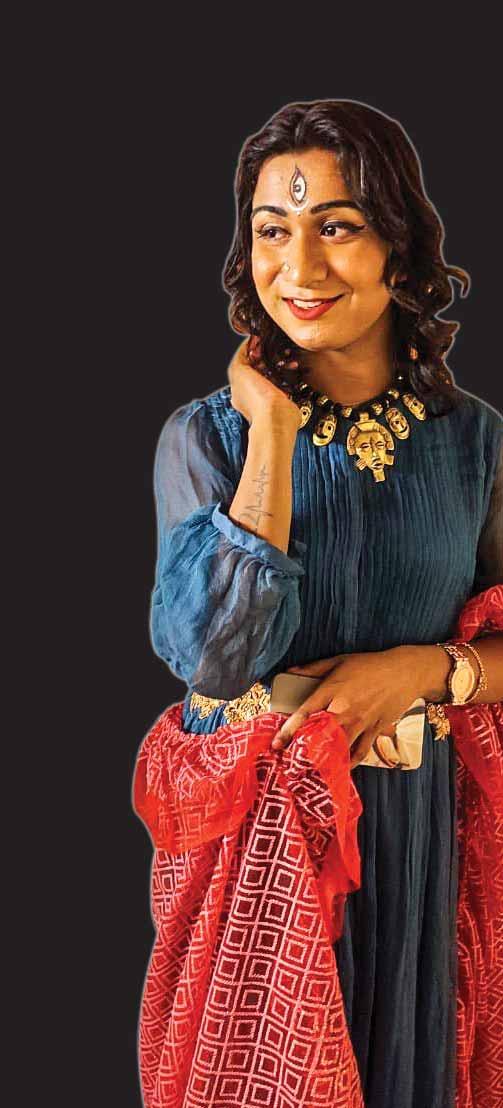

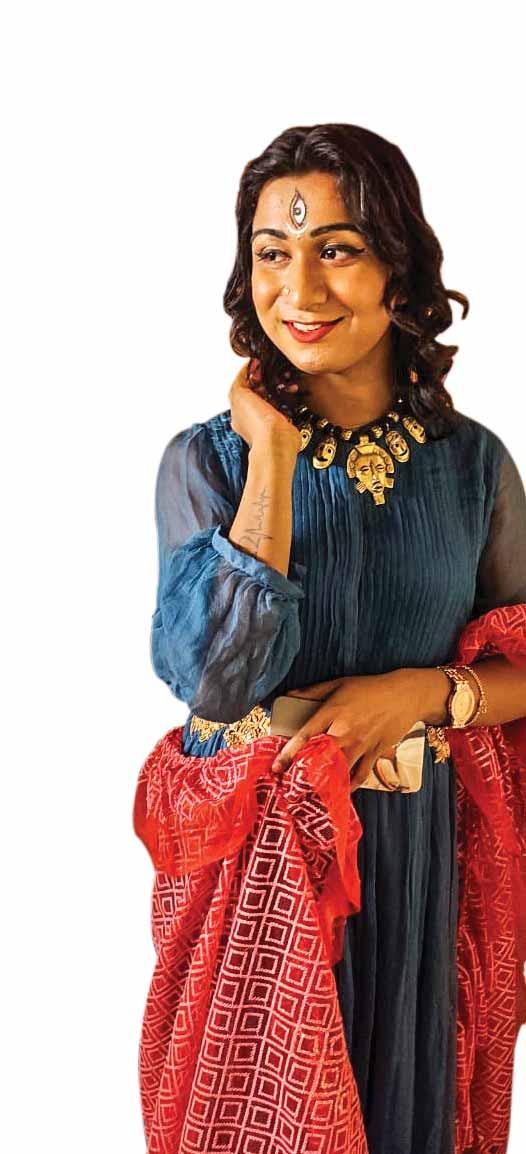
Kiran Zehra
Sridevi, from Taraimal village, Chhattisgarh, who had been silently suffering from a urinary tract infection, was one of the persons seeking care at a medical camp organised by RC Raigarh Royale, RID 3261. Unaware of the cause of her distress, the 36-yearold would often find herself “rolling on the ground in agonising pain. I lived with the pain for over a year,” she says. Dr Madhulika Beriwal, a gynaecologist and spouse of club member Dr Manish Beriwal, present at the camp, noticed her agony and came to her aid.
Driven by her genuine concern for the well-being of women in the village, Dr Madhulika took it upon herself to counsel the women present at the camp on safe sex practices, menstrual hygiene
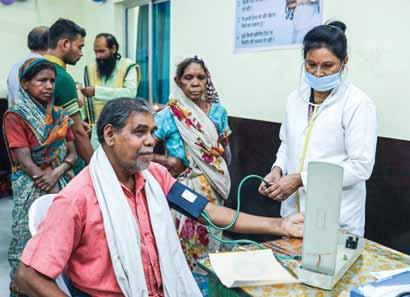
Above: A villager being examined at the camp.
Below: DG Shashank Rastogi (secong from L), along with club members, at the inauguration of the water cooler project.
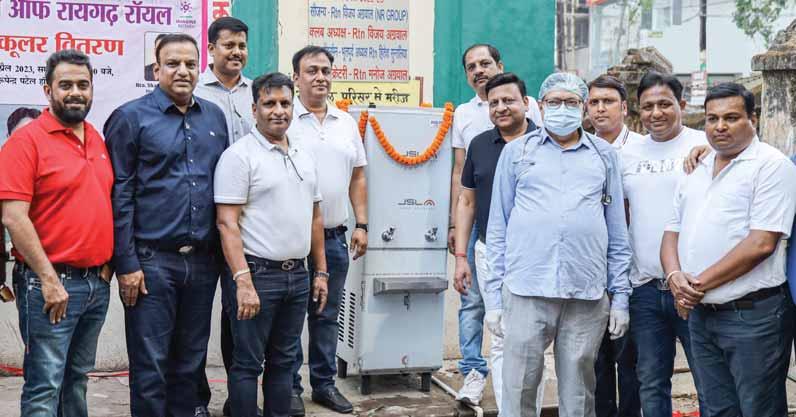
management and toilet sanitation, then and there. “I wanted to make them aware of the critical role hygiene plays in their overall health and well-being,” she says. Her impromptu counselling session “highlights how Rotary transforms you as a person. I am not a Rotarian but I have seen my husband do amazing service through his club and I guess that caught on,” she smiles. Sridevi, who has completed her prescribed course, says “now I keep my toilet clean to avoid infections in the future.”
Joining forces with the Indian Medical Association and NR Trauma Hospital, the club organised
its second mega health camp in the rural areas of Chhattisgarh “to improve healthcare accessibility and create awareness about crucial health issues among village residents,” says Om Prakash Modi, the club’s president-elect.
The camp was inaugurated by Kumari Laxmi Bhagat, the village sarpanch, and saw a footfall of over 600 villagers. Nearly 500 patients received comprehensive medical attention from a team of dedicated healthcare professionals examining them for a wide range of ailments, including blood pressure, sugar, ENT, orthopaedic, dental and gynaecological ailments.
The sarpanch expressed her gratitude to the club for organising this camp. “I am glad that women’s health has been the highlight of this camp. Not only were patients provided with medical consultation, they were also given free medicines, ensuring that we could access necessary treatment without financial constraints,” she said. She also requested that the club conducts a similar camp at another village near Taraimal.
The club, in the presence of DG Shashank Rastogi, installed water coolers at four locations in the city, as part of its ongoing water project Jal Mission Yojana.
Guidelines for Rotary Foundation (India) contribution via Rotary.org
Use My Rotary login to avoid duplicate ID generation and receive timely credit of your contribution under your club. Or use your registered email address while making online contribution
Re-check your PAN before submitting. For all online contributions, 80G receipt will only be generated in the name of remitter whose My Rotary login has been used for making the contribution.
In case of contributions from family trust/company, send cheque/bank draft to RI South Asia Office. Do not make these contributions through My Rotary.
Contribution by individual donors through Dynamic Virtual Account
In Oct 2022, RISAO introduced a new channel called ‘Dynamic Virtual Account’ for Indian donors to contribute to Annual Fund or PolioPlus. This channel allows donors to make offline NEFT/RTGS payments through their personal bank account including recurring payments. For more details refer:http://www.highroadsolution.com/ file_uploader2/files/dynamic_virtual_account.pdf
RID 3141 tested the pilot programme for payment of TRF contributions through this channel. “We tested this with great enthusiasm as it promised to take care
of many of the oft repeated complaints of incorrect or delayed credits and non-issuance of receipts to donors. It functioned flawlessly and this led to roll out of this channel on a pan-India basis by RISAO. I strongly urge all districts to take advantage of this most effective channel to improve all-round efficiency. Accurate capture of contributions to TRF and quick issuance of credit and receipt in turn leads to donor “delight” which helps increase our giving to TRF.”
Foundation recognitions
For every donor, TRF helps you say “Thank You” through various recognitions. Learn more about the various forms of individual and club recognitions on the Donor Recognition webpage (https://www.rotary.org/en/donate/recognition) on Rotary.org
Appoint District Foundation positions
To achieve fundraising goals of 2023–24, have a right team in place. Appoint your district chairs for Fundraising, Annual Fund and PolioPlus subcommittees, Endowment/ Major Gifts, CSR, and District Paul Harris Society coordinator, and report them to RI so that they have access to reports and information that can help in their efforts. To report these appointments, sign in to My Rotary, go to “Manage”, and then select the District Administration tab.
In its endeavour to make a positive impact on senior citizens living in old age homes across the city, RC Nagpur Ishanya, RID 3030, recently carried out a heartwarming project called Muskaan - The Joy of

Giving. Under the initiative, they were taken out on a fun outing.
Club members had to gather information about the old age homes and identify the seniors who were fit to be taken on a
An elderly woman gets a temporary tattoo, a fun activity that was arranged during the picnic.
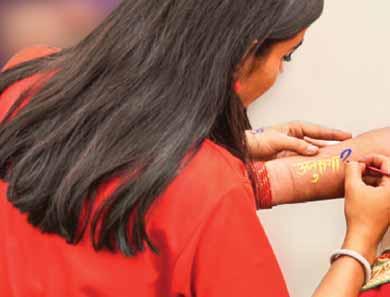
one-day picnic. They were able to identify 150 beneficiaries from 10 old age homes and took them to the Telankhedi Hanuman Mandir grounds in buses, along with 30 caretakers.
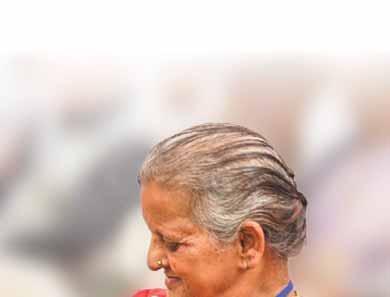
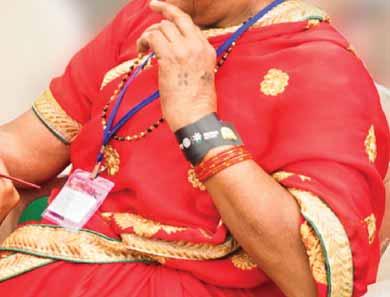

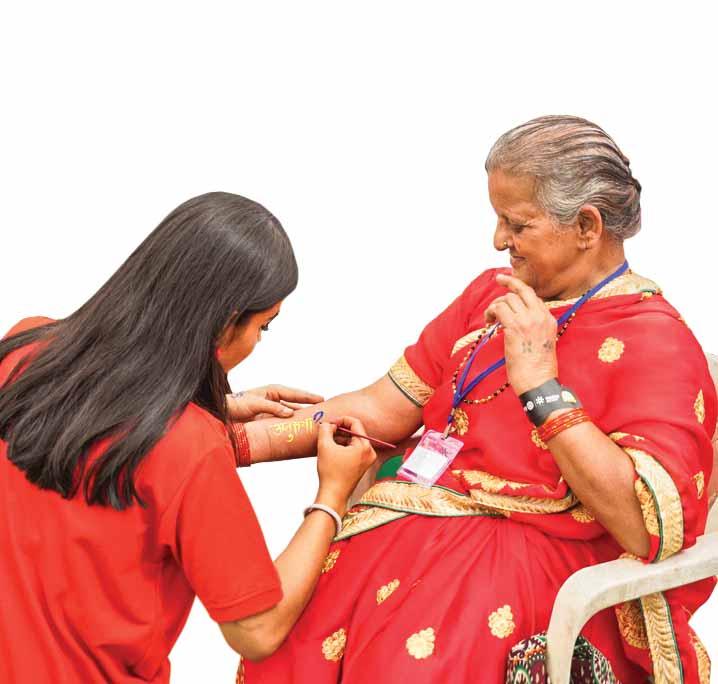
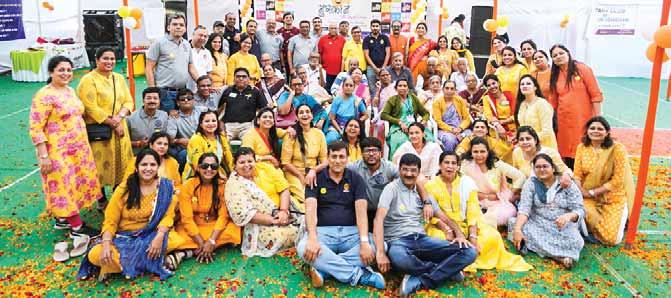
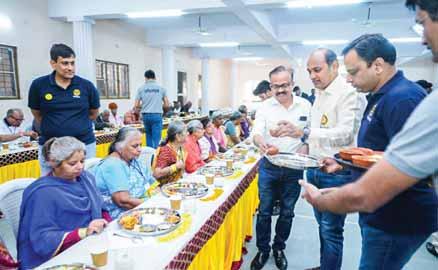
Upon arrival, the seniors were welcomed by a group of 50 Rotarians, who adorned them with a chandan ka tilak and sang songs to greet them. The morning started with a breakfast of tea, biscuits and bananas, followed by a visit to the temple. To liven up the day, the club arranged games like Antakshari
Rotarians served them a grand vegetarian thali followed by ice cream and desserts. The second half of the day was filled with entertainment activities, including a magic show, Holi with flowers, and a dance with club members.

Rotarians enact a religious play for the senior citizens.
Dialysis machine for Ottapalam Hospital
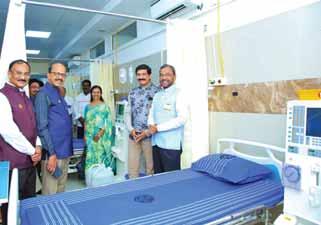
DG Rajmohan Nair and Meera Nair at the inauguration of the project.
In association with RC Tijuana Oeste, RID 4100, Mexico, and TRF, RC Ottapalam, RID 3201, handed over four dialysis machines worth `26 lakh to PK Das Hospital in Ottapalam, Palakkad, Kerala.
A blood collection van in Kakinada
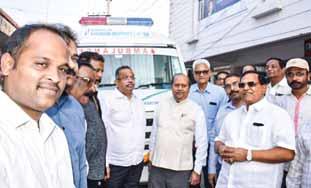
PDG SVS Rao and KV Rao, the owner of Kakinada Seaport, handing over the van to the blood bank.
RC Kakinada Golden Jubilee, RID 3020, recently handed over a blood collection van worth `28 lakh to the Rotary Blood Bank, Kakinada. Kakinada Seaport was the CSR partner for the project.
A sanitation complex at a girls’ school
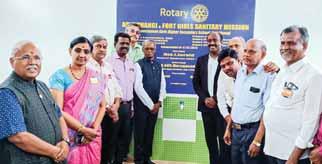
DG I Jerald after inaugurating the project in the presence of DGN Raja Govindasamy, DGE Anandtha Jothi, PDGs S Gopal, AL Chokkalingam, S Gopal and DRFC RVN Kannan.
DG I Jerald inaugurated a two-storey sanitation complex worth ` 23.17 lakh at the Government Girls’ Higher Secondary School, Aranthangi. This GG project was done by RC Aranthangi, along with RCs Tiruchirapalli Fort, RID 3000, and Bandar Sungai Petani, RID 3300, Malaysia. The facility has 10 handwash stations, eight toilets and 21 urinals.
A pain management camp at Sonipat
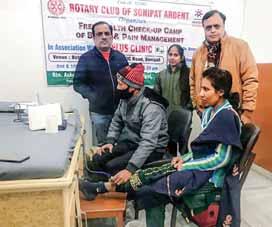
A patient being treated at the camp.
RC Sonepat Ardent, RID 3012, is organising a monthly pain relief and management camp for the underprivileged in the city in collaboration with the Eplus Clinic, orthopaedic doctors and pain management specialists. An average 120 people benefit from this camp every month.
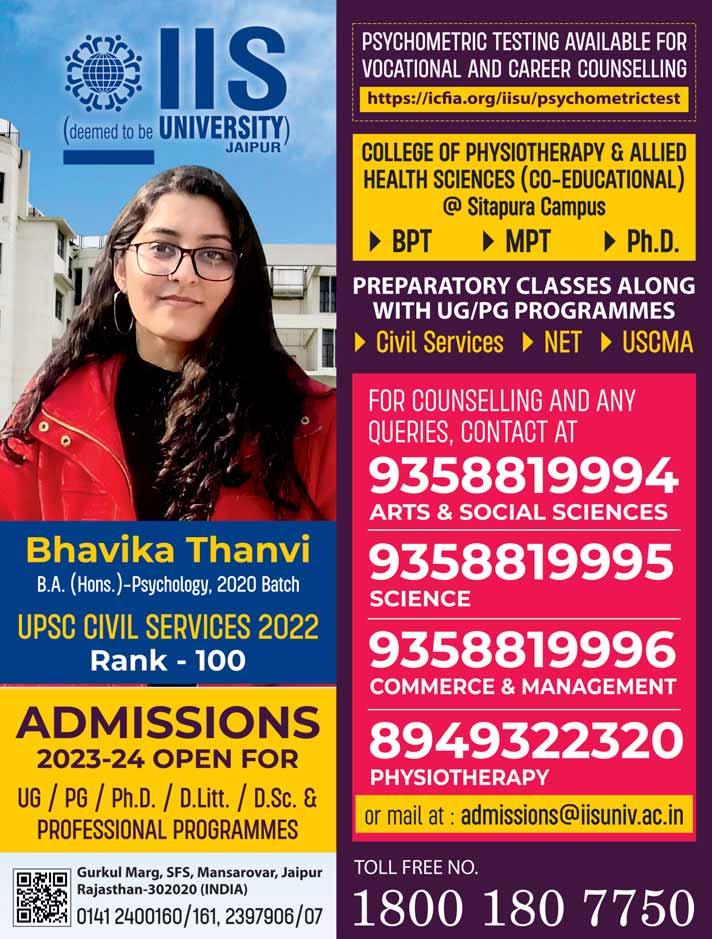



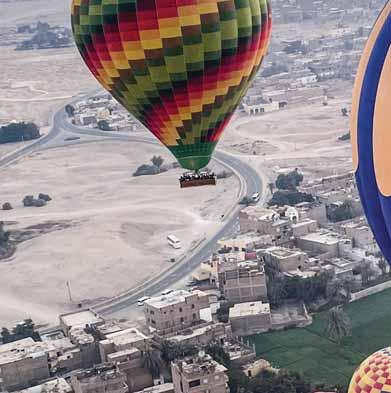
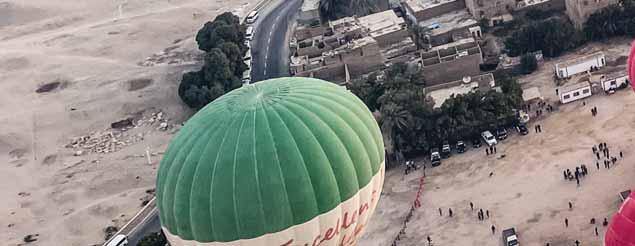

Hot air balloons flying over the Nile valley.


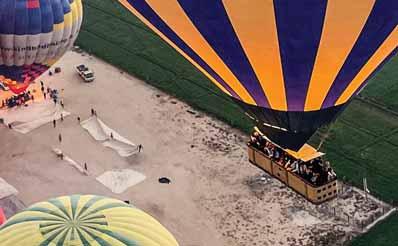
Mention Egypt and the Nile and the first thing that comes to mind are the pyramids, and the second one, specially when you think of a grand barge on the Nile, where a royal beauty is floating over its serene waters, is the Egyptian Queen Cleopatra. The majestic Cleopatra of Shakespeare’s Antony and Cleopatra and of course the stunningly beautiful Elizabeth Taylor featured in the 1963 epic Hollywood classic Cleopatra, also featuring Richard Burton as Mark Antony and Rex Harrison as Julius Caesar, and directed by Joseph L Mankiewicz.
Who can forget, in that movie, Cleopatra’s spectacular entry into Rome, or Taylor asking an infuriated Burton to kneel before her, saying: “I asked it of Caesar, I demand it of you!”
So I went to Egypt hoping to hear many legends about Cleopatra, only to be disappointed. Whether it is in the museums of Cairo, or the trinket shops in Luxor or Cairo, you will see much more of the beautiful Egyptian Queen Nefertari, Ramesses II’s favourite wife, as alsoQueen Nefertiti, ancient Egypt’s most iconic symbol, than Cleopatra. The wife of King Akhenaton, Nefertiti (1367–1350 BC) played a prominent role in changing Egypt’s traditional polytheistic religion to a monotheistic one, worshipping the sun god Aton. She was also the stepmother of the great king Tutankhamun. While reading up on her, I found this info: “An elegant portrait-bust of Nefertiti now in Berlin is perhaps one of the most well-known ancient sculptures.” Should give a sense of déjà vu to Indians.
Queen Nefertari was famous for her dazzling beauty and often referred to as “one for whom the sun shines” and is prominently displayed in the majestic rock cut temple of Abu Simbel, where majestic figures of Ramesses II rule supreme. Predictably enough, thanks
to her comeliness, she also features prominently on all the trinkets and souvenirs tourists bring home, such as magnets, bottle openers, key chains and even rings and ear rings!
Anyway, though I was disappointed at the missing buzz about Cleopatra — the odd sculpture/portrait of her you do manage to see comes nowhere close to the dazzling persona portrayed by Taylor, and you’re happy to leave that legend alive in your head, the Nile cruise had plenty to offer.
We took a four-day Nile cruise, and to board the ship, we had to take a cruel early morning flight from Cairo
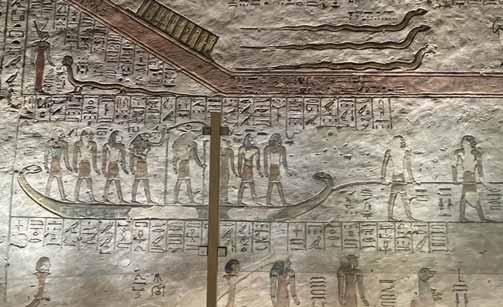
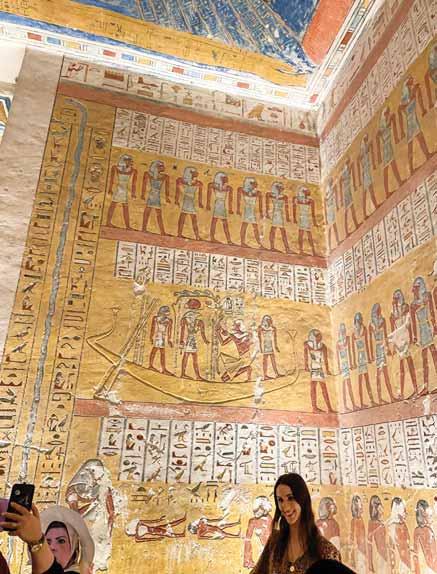
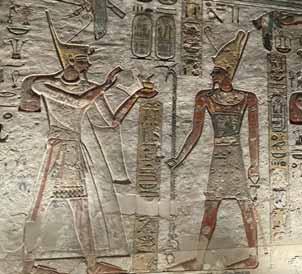

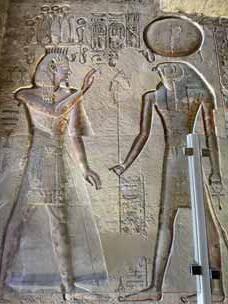


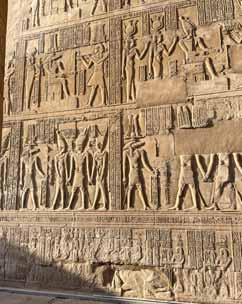
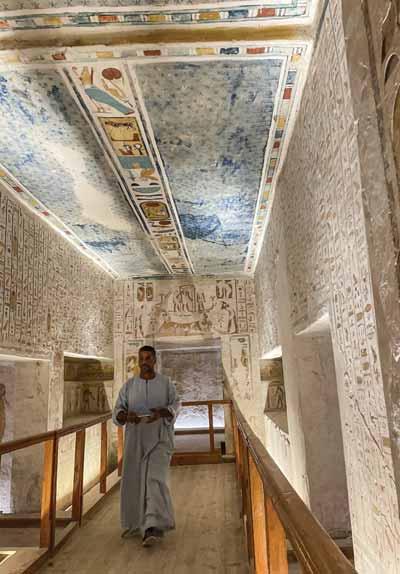
to Aswan, from where we drove to the incredible Abu Simbel temple first, before boarding the cruise in the afternoon at Aswan.
It is said the Nile was to Egypt what the Alps are to Switzerland and the sea to Britain. It fashioned the nation’s economy and determined its political structure. The longest river in Africa — a massive 6,650km in length — is present in 11 countries. Two great streams converge to form it — the Blue Nile in Ethiopia and the White Nile in Uganda. To appreciate its importance, you just have to picturise this huge, elongated oasis in the middle of massive desert land, that has nurtured and nourished civilisations for thousands of years.
Ancient Egypt was known as a gift of the river; without it, the land would have been barren; with its blessings, the pharaohs ruled one of the richest lands of the era. The Egyptians never had to look at the sky for rain; the Nile always irrigated the land. Every summer, when its swollen waters receded, they left behind rich, fertile black soil perfect for their crops. But often there were disastrous floods.
From Aswan, after a 3-hour drive (about 230km) we reached an awe-inspiring historic site comprising two massive rock cut temples in the village of Abu Simbel, which is close to the border with Sudan. Carved out from a mountain in 13th century BC during the reign of Ramesses II, what greets you are gigantic figures of this famous Egyptian pharaoh. While Ramesses II’s statues are shown wearing a crown to denote both Upper and Lower Egypt, his wife Nefertari and children can be seen in smaller figures carved on the same rock. Ramesses II’s 66-year reign undoubtedly took Egypt to the pinnacle of both power and glory.Hailed as the
“ruler of rulers”, the Britannica points out that “he recognised that diplomacy and an exhaustive public relations campaign could mitigate any military shortcomings. He erected more monuments and statues — and sired more children — than any other pharaoh.”
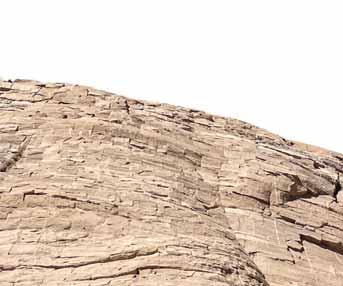
Abu Simbel was one of the most ambitious construction projects of the pharaoh, and of the two temples, the Great Temple was dedicated to Ramesses II himself, and the Small Temple to Queen Nefertari. Lasting for about 20 years, this massive construction was completed in 1244 BC. Over the passage of time and due to disuse, most of the Great Temple, and
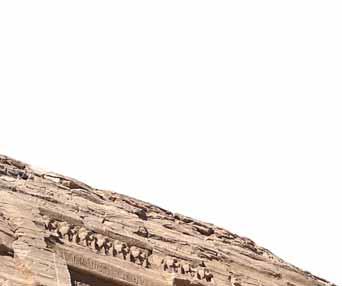

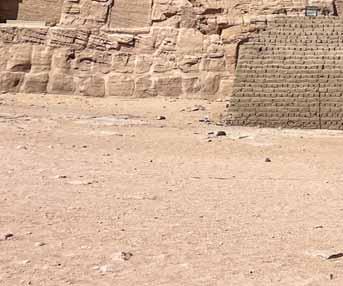
the figure of Ramesses II got covered by a sand dune. Can you imagine, this gorgeous piece of art was forgotten till March 1813, when Swiss researcher Johann Ludwig Burckhardt found the Small Temple and top frieze of the main temple. After several attempts these temples were reclaimed from the sand, though one of the massive statues of Ramesses II was permanently damaged.
But when the Aswan High Dam, one of the world’s largest embankment


dams, was built across the Nile in Aswan, between 1960 and 1970, the rising waters of the Nile threatened the Abu Simbel monuments, which started getting submerged in the water. An international campaign began to gather funds to save these priceless wonders of an ancient civilisation.
How the world’s nations rally around to save historic treasures, even though located in lands far away, can be seen from the fact that in 1964 a multinational team of archaeologists, engineers and skilled heavy equipment operators, working together under the UNESCO banner spent some $40 million at that time (equal to around $348 million today in value, according to an inflation calculator) to relocate these monuments.

During those four years, in one of the greatest challenges of archaeological engineering, the entire
site was carefully cut into large blocks of between 20 to 30 tonnes each, lifted and reassembled at a new location that was 65 metres higher and 200 metres away from the river. Some structures, already submerged in the water, were also salvaged, so that visitors like us could go there, admire the magnificent beauty of the work that was done as far back as in 1244 BC.
If anything, a visit to ancient civilisations like Egypt, and the historic wealth and beauty that nestle in its bosom, give us, 21st century netizens, ample humility and helps shave off a bit of our arrogance that we belong to a much superior technological era.
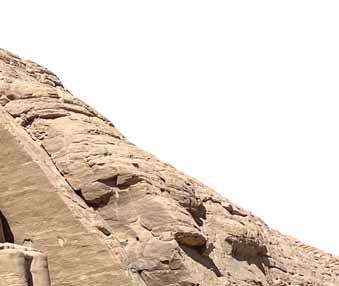
In the evening we boarded our relatively small, but extremely comfortable, ship which took us to Luxor and the Valley of the Kings the next day.
The Valley of the Kings is famous for its beautifully etched and painted royal tombs. As is well known and chronicled, the Egyptian kings and royals firmly believed in the afterlife and so it was mandatory for them to have beautifully decorated final resting places, amply filled with everything that a mortal can need in the next world…
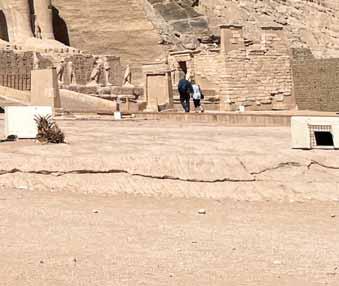



wealth, treasures, fine clothes, jewellery and food and drink of the topmost quality. What better place to create the world’s most magnificent burial ground for the mighty pharaohs, their queens and other royals of Egypt than close to the bank of the Nile?
So for over a thousand years of the New Kingdom of Egypt (1500–1070 BC) the kings, queens and nobles were buried in this Valley, also known as the Valley of the Gates of the Kings. Their bodies were suitably mummified. Designated a World Heritage Site by UNESCO, right from the 16th to 11th century BC, some of the most beautifully decorated, but secret tombs were created for the most powerful men and women of the kingdom. The entrance to these tombs was skilfully hidden with secret doors to prevent “grave robbers” as the pharaohs and other royals were buried along with a lot of gold and other treasures which they believed could be used in the afterlife. Prior to this era, several royal tombs were vandalised and looted for their valuables. According to one account, archaeologists have so far discovered 63 tombs and work is on to find more.
While the rulers were buried in these magnificently carved and decorated tombs, their family members were buried in smaller rock chambers near the king or pharaoh’s tomb.
These tombs will take your breath away, the walls are decorated with etchings and painted in beautifully muted colours. Predictably enough, the painted scenes embossed on the walls are of pharaohs, gods and goddesses, with hieroglyphic text also encrypted on the walls to guide them to the next life.
It was believed that the process of mummification would prepare their bodies to wake up properly in the next life. An interesting observation made by our extremely well- informed and smart guide Manal was that none of these resting places had books



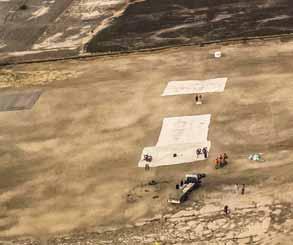


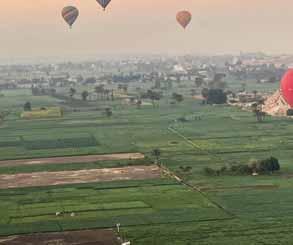
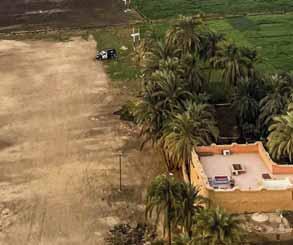


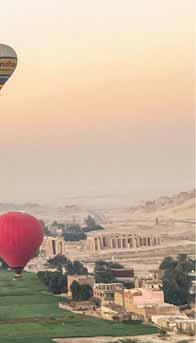
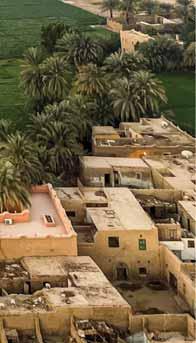

“because probably the pharaohs believed that they needed to start their next life on a completely new and blank page.” Not a bad idea at all!
Our romance with Egypt continued through another early morning adventure — a hot air balloon ride over the vast, green Nile valley, and of course the Valley of the Kings. At the crack of dawn, adequately covered in woollens and rubbing our eyes we were transported first by a boat, and then a van, to one of the facilities offering a hot air balloon ride. Having done a similar ride in Cappadocia in Turkey earlier, Pervez and I had comparatively fewer butterflies in our tummies compared to the others! But of course, thoughts of the odd chance of a sudden terrible gust of wind crashing your basket, made of straw but sturdy nevertheless, did lurk in a corner of the brain.
But our tall, strapping, handsome and extremely competent pilot soon put our little nagging doubts to rest by giving us a matter-of-fact but detailed briefing on how to brace, bend on our knees, crouch and keep calm in the event of the wind not behaving itself. Considerably calmed, and
more excited than frightened, we found ourselves soon lifted up by the balloon, as the fire in the chamber below the basket was lit. Soon we were drifting in the sky, breathing in the cool, fresh air, and watching the sprawling Nile valley and the shining waters of the river beneath us and the fields made lush green through its bountiful waters.
And then the real magic happened. The majestic sun began to make its appearance through the pink and then red sky, lighting up the whole expanse below us in its magnificent light and giving us a breathtaking view of the land below. We simply surrendered to this exhilarating and unforgettable experience. Before we knew it, the 45 minutes were up and we made a smooth, soft
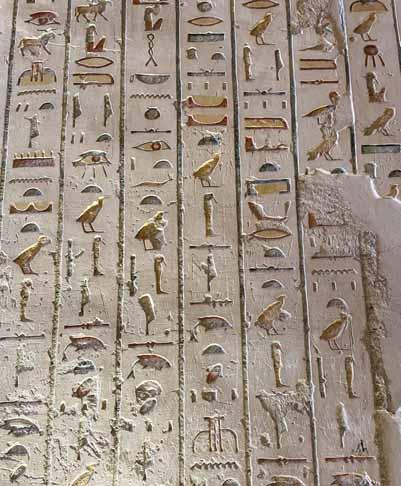

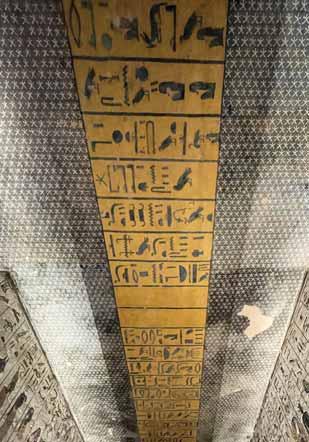
and uneventful landing, without having to bend or crouch!
In Cappadocia, we were treated to a glass of sparkling wine after the completion of the balloon ride; in Egypt there was no such luck, but we did return for a sumptuous breakfast on our ship. Once again, the request of the lone vegetarian in our group was given the topmost priority, and as happens at international Rotary events, the (Indian) vegetarian fare was tastier and much in demand here too!
Another amazing monument in Luxor is the Hatshepsut temple, built by Queen Hatshepsut of the 18th dynasty. One of the most prolific builders in Egyptian history, she was the longest reigning female pharaoh of Egypt, and curiously, and perhaps because it was very much a man’s world when it came to leadership, made a very conscious attempt to alter her image to look like a male by donning male clothing.
There is so much to see and ponder over in Egypt that even a 10-day trip was not sufficient for us to come away feeling satisfied that we had a fill of the land of the pharaohs, and one of the oldest centres of civilisation.
We came away with a promise to return… and had to nurse our aching feet and creaking joints, not to mention protesting knees for quite a while. One sincere advice to those with wanderlust — travel as much as you can… even on shoestring budgets if need be, when you are relatively young.For, in a country like Egypt, there is so much to see, and such long distances to tread, that fitness is of primary importance to really enjoy the country.
(Concluded)
Designed by N Krishnamurthy

US Dollars)
48,424 130,075 68,146 613,517 464,082 220,217 146,635 136,597 118,319 65,085 296,158 168,286 127,029 20,463 119,293 909,026 35,713 1,981,691 111,619 3,875,476 633,068 373,451 35,938 373,834 133,138 102,678 689,327 1,139,532 154,507 36,698 216,188 555,061 136,986 1,041,995 157,667 66,121 37,317 89,249 176,736 15,805,340 97,653 27,347 25,242 284,890 68,212 379,404 16,688,088 1,184 75,739 100 492,090 369,330 2,155 2,791 110,053 40,757 35,114 161,833 11,347 80,262 0 8,960 823,935 0 1,387,834 5,602 2,796,008 278,455 66,102 3,675 54,236 4,306 11,260 381,523 813,899 76,209 17,167 6,729 81,306 15,044 738,186 3,850 40,486 5,277 34,165 12,346 9,049,314 1,420 1,500 6,000
Jaishree
For the past four years RC Delhi South, RID 3011, along with Rotary Clubs of New Delhi and Delhi South End, the Lepra Society, India chapter, corporate partners Aimil, instrument makers, and Assets Care and Reconstruction Enterprise (ACRE), has been carrying out extensive relief work across 33 of the 40 leprosy colonies in Delhi NCR through its Leprosy Control Project. “We owe it all to our club member PDG and INPPC chair Deepak Kapur,” says Pradeep Bahri, past president of RCDS.
When Kapur, on a vacation to the UK in June 2019, met Nayen Patel of RC London, the latter spoke about his involvement with Lepra (Leprosy Relief Association)-UK, and introduced the visitor to its CEO. “Until three years ago we believed that leprosy was a disease of the past and had no idea of its prevalence and spread. So it came as a shock to us when Kapur returned and told us these details. The highlight of it was the WHO’s report that 60 per cent of the global new leprosy cases are in India, while we were under the impression that India had eliminated leprosy as a public health problem in 2005,” explains Bahri, who was then RCDS president. Immediately the
club tailored its service projects to address the disease and formed the Rotary Club Alliance for Leprosy Control in October 2019, with Bahri as its CEO and PDG Kapur as its chairman.
The Alliance developed a four-pillar strategy that focused on creating awareness, training medical professionals, identifying patients, and providing healthcare to control leprosy. Though it is completely curable, leprosy remains one of the most misunderstood and underreported diseases, mainly because of lack of awareness about the disease, its treatment and management. This project aims to dispel the social stigma surrounding leprosy, improve medical care and the quality of life for patients, says RCDS president Lalit Sawhney.
Adds Bahri: “Leprosy patients today are not just battling with diagnosis and treatment, but they
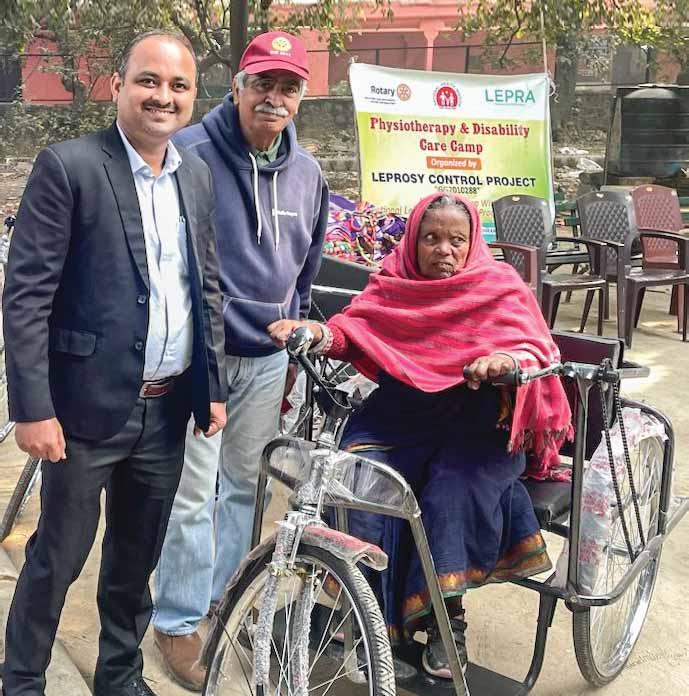
are also fighting for their right to dignified living. Most of them suffer in isolation as outcastes in around 750 leprosy colonies in India. Delhi has 40 such colonies.”
With support from GoI’s National Leprosy Eradication Programme, the Alliance has trained medical professionals to detect the disease, and provide physiotherapy, dressing of patients’ sores and offer palliative care. A mobile ulcer management clinic was commissioned for these services and to distribute specially designed shoes and self-aid kits. “We visit public places and residential colonies to spread the message. We have even uploaded a jingle related to leprosy which is being played in garbage collection vans that visit streets to collect door-to-door garbage,” he says. Tricycles and wheelchairs were distributed to more than 130 patients in various colonies.
The Alliance received a `78 lakh global grant, with RC Stratford London as its international partner, to provide medical care for patients in these colonies. A Leprosy Control Foundation was also formed to gather funds for the programme.
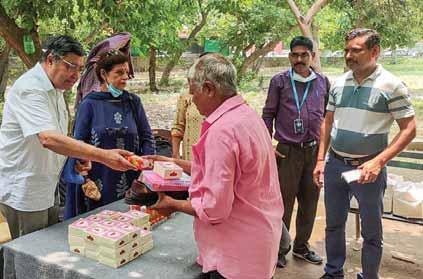
“During Covid, we distributed 400 food packets daily for two months in two colonies, in partnership with a Rotary club in Bengaluru,” says Sawhney. Battery-operated solar power plants were installed in two colonies. More recently, an on-grid solar power plant costing `15 lakh was installed at the Mother Teresa Home located at a leprosy colony in Tahirpur, near Faridabad, with CSR funding from ACRE. “It will
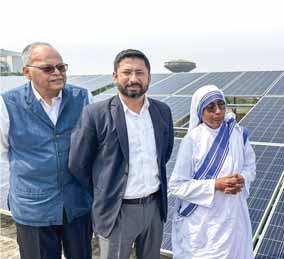

after the inauguration of the facility.
help the institutions to significantly save on electricity costs,” he adds.
Following the success of this project, an NGO, The Leprosy Mission India has sought help to provide vocational training and sponsor reconstructive surgery in its Leprosy Care Hospital in Tahirpur. “Our corporate partner Aimil is ready to support this,” says Bahri.
A Rotary-Lepra Referral Centre will soon be set up at the Delhi government’s Indira Gandhi Hospital. “With CSR grant from Aimil we have bought equipment to be installed in this centre to provide physiotherapy, ulcer management and reconstructive surgery,” he adds. The Alliance is all set to conduct screening camps for 18 lakh government schoolchildren in the capital.
The Leprosy Control Project is a 14-year programme to be carried out in phases. “With the successful implementation of the pilot begun in Delhi NCR, the model will gradually be expanded to other parts of India, making it effective and sustainable,” says its CEO.

Preeti Mehra
There are a host of activities that can be done collectively to ensure a sustainable lifestyle.
Charity, they say, begins at home. But when it involves going green it must also spread to the immediate neighbourhood, and then to the larger community. Only then will there be a multiplier effect for the good practices that you have started at home. Indeed, when you can influence people around you, you can have the satisfaction of seeing your effort reflected in your community, colony and your city.
When it comes to preserving and saving the environment there is nothing that matches community work. And the first step towards it is talking ‘green’ to your friends in the area you live, and then collectively getting together and later involving the others you do not know about it so well. Apart from making more friends, you could be part of a host of activities that would transform the lives of many families.
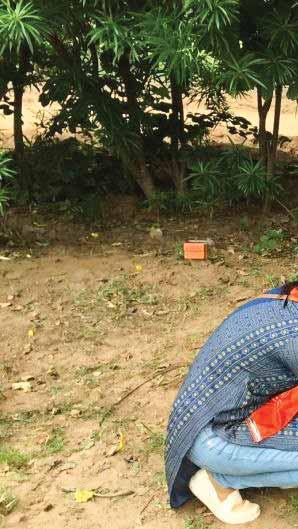
world environment. Our colony in Delhi has a group that cleans up the municipality park twice a month, and what a difference it has made!
Besides the savings, the act of coming together and creating green, safe spaces for children as well as senior citizens can be a thoughtful gift that enriches you and the community.
The choice of activities is endless. If you live near a water body, you could all collectively resolve to clean it up. Most lakes, rivers and streams in India are strewn with plastic, assorted waste, cigarette butts and more. It would not be a bad idea to enthuse neighbourhood children to dedicate a holiday and volunteer to help the adults clear up the area and breathe life into a river. They could also help collect funds to install trash specific cans alongside the water body.
This could be done at the beach too, or in the hills. If plastic is not removed, it can stay in a water body for 400 years and be part of the microplastic problem plaguing the
Recycling is another important activity that could be turned into a great community effort. Your green group could choose a day when everyone brings out household articles they wish to dispose. Someone else may need that vase you don’t, you may be looking for a baby’s pram or a cot that is taking precious space in another’s home who has no use for it now. Ditto the odd casserole, book, filing cabinet or even a printer that the owner does not need. Ideally this should a free exchange within the group, but if some people want to put a small price to the item, that too serves the purpose of sustainability’s three Rs — reduce, reuse, recycle.
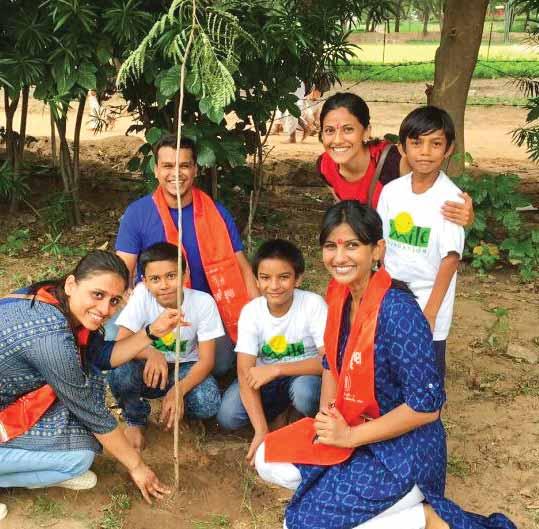
With electric vehicles coming into the country in a big way and almost all families thinking of shifting to an e-vehicle once their existing one reaches end of life, collectively setting up an electric charging station in a common shared parking space allocated for the entire colony makes a lot of economic and green sense. If everyone pays for the facility and shares the electricity bill it will come to next to nothing for every resident. This will also attract new environmentallyconscious residents to the fold.
The other transport-oriented community activity is starting a carpool where neighbours map their regular routes and take turns to use their vehicle. We would not only be saving precious fossil fuel but also reduce emissions in the city we live in.
If you live in a high rise that has a common terrace for all, a communitysupported kitchen garden initiative can go a long way to give the entire community fresh greens. All you need to do is pool in to start a hydroponics venture that those with a green thumb can attend to in their free time. It is not difficult to start such an initiative if an expert starts you off. Imagine the whole building sharing a harvest of basil leaves, celery, methi (fenugreek leaves), palak (spinach) in turns! If you want to make it cost-effective people could buy the produce for a nominal amount. And if hydroponics is not the choice of your group, a community garden and making compost collectively can certainly be executed by all.
It is wisely said that there can be no activity as pleasing as planting
trees. And you can do this in vacant areas within the community commons or outside. The trees will clean the air, provide shade in summer and increase the value of your property. One way to do it is to let it slowly become a practice of planting a tree on each community member’s birthday or if there is a wedding or a birth in the family. Some tribal communities follow such a ritual, enriching the environment and their lives in the process.
A very important community activity could be centred around the issue of energy. Setting up community solar panels to provide energy to every home could reduce your electricity bills. Of course, there will have to be a one-time investment by each family, but in the long run it is a cost-effective alternative.
Apart from this, upgrading to LED bulbs, both inside each house and in the common areas can again make a big difference to your bills and to the environment. The LED bulbs available today are more energyefficient and use around 80 per cent less power compared to traditional fluorescent and incandescent lights. Besides, the LED bulbs have six times longer life than conventional bulbs, making it a cheaper and more sustainable alternative. Of course, if you live in a city with lots of sunlight, you could even opt for solar-powered LED lights for the outdoors.
Besides the savings, the act of coming together and creating green, safe spaces for children as well as senior citizens can be a thoughtful gift that enriches you and the community. It also feels good to participate in activities that shows each one of you cares for Mother Nature.
The writer is a senior journalist who writes on environmental issues






Payments can be made online at HDFC Bank, Montieth Road, Egmore, Chennai. Rotary News Trust SB A/c No 50100213133460 IFSC: HDFC0003820
Email us the UTR Number, Club Name, President/ Secretary’s name, Amount and Date of Transfer. Annual Subscription ( India) Print version ` 480/e-Version ` 420/-
No. of Copies
For every new member the pro-rata is `40 a month.
Please attach the TYPED list of individual members with their complete address, PIN code, Mobile number and e-mail ID. Intimate language preference (English/Hindi/ Tamil) against each member’s name.
Rotary Club of .......................................................................................................... RI District ................................
Name of the President/Secretary .............................................................................................................................. Address ....................................................................................................................................................................
City ............................................. State ................................................................ PIN STD Code .................................. Phone: Of f. ....................................... Res. ............................................................ Mobile .......................................................... E-mail ...............................................................................................
Cheque/DD No. ......................................... Dated .............................................. for Rs. ............................................
Drawn on .................................................................................................................................................................. in favour of “ROTARY NEWS TRUST” is enclosed.
Date: President/Secretary
Mail this form to: Rotary News Trust, Dugar Towers, 3rd Floor, 34, Marshalls Road, Egmore, Chennai 600 008. Tamil Nadu, India. Ph: 044 4214 5666, e-mail: rotarynews@rosaonline.org
1. Subscription is for the Rotary year (July to June).
2. It is mandatory for every Rotarian to subscribe to a Rotary magazine.
3. The annual subscription for print version is `480 and e-version is `420 per member.
4. Subscription for the full year must be sent in July in the prescribed form.
5. Those joining after July can pay for the remaining Rotary year at `40 an issue for print version and `35 for e-version.
6. Subscription account of the club with Rotary News is a running account and does not cease at the end of June every year.
7. Names of all members with their complete postal address including PIN CODE, mobile number and e-mail ID must be sent along with the form and DD/cheque payable at par. Online transfers can be made through GPAY or netbanking. When you make an online payment share with us immediately by WhatsApp (9840078074) or email (rotarynews@rosaonline.org) the UTR number, your club name and amount paid. If this is not done
your payment will not be updated in our records and your club will show dues outstanding.
8. Language preference (English, Hindi or Tamil) should be stated alongside member’s name.
9. Update the correct mailing address and contact details of your members directly to Rotary News every year to receive the magazine regularly. RI does not share member details with us.
10. Members to ensure their names are included in the subscribers’ list their club sends us. If you’ve paid, but your name is not sent to us by your club, you will not get a copy of the magazine.
11. If you’ve not received your printed copy to which you had subscribed, check with your club president if your club has opted for e-version.
12. Clubs must immediately update
membership status to enable us to deliver the magazine to the new members.
13. Clubs are liable to pay for the number of magazines we despatch
Beginning July 1, 2022, the RI Board has included in its Rotary Code of Policies the termination of Rotary clubs that do not subscribe to a Rotary magazine. A quarterly report on non-compliant clubs is being sent to RI by our office, after notifying the respective club leaders and the DGs. These clubs are given a 90-day grace period after which the defaulting club is placed under suspension by RI.
according to the list available with the Rotary News Trust.
14. Unpaid dues of the club will be shown as outstanding against the club. Any payment received subsequently will be adjusted against earlier dues.
15. Details of clubs with subscription arrears will be shared with RI and are liable for suspension.
16. We regularly verify our subscriber’s list that clubs share with us with that of RI’s data to detect missing subscribers.
17. If a member has not received the magazine for a month, inform us immediately so we can resolve the issue. Magazines are sent through concessional book post; so postal tracking is not possible. You may not receive your copy if your club has not passed on your subscription to us. So please check with your president or RNT for your enrolment in the subscribers’ list.
18. There may be delivery issues in some areas. In such a situation clubs can opt and receive copies in bulk. Additional charges will be applicable.
For clubs that stay suspended and are non-compliant for 180 days, RNT, after notifying RI, sends a reminder letter stating “the Board at its discretion can terminate this club.”
Club presidents, please urge your members to subscribe to Rotary News, and get a full picture of Rotary activities in India. RI recommends inclusion of information about mandatory subscription in your PETS/GETS curriculums.














Madhu
In 1963, Dev Anand was busy with his magnum opus Guide. Music composer SD Burman fell very ill after composing just one song of the 10 songs planned. Dev refused to engage any other composer, saying, “I’ll wait for you to get better.” “And what if I don’t?” asked Burman. “Then I’ll release the film with just one song,” countered Dev.
on a flamboyant Waheeda); Gata rahe mera dil (another infectious Dev-Waheeda romantic song in the vocals of Lata and Kishore); Piya to se naina lagey re (an eight-minute dance classic); and of course Wahan kaun hai tera, the peerless background song by Burman himself for the film’s opening scenes. Dev’s belief in Burman was fanatical. “I can’t forget what his music did for Navketan Films (owned by Dev and brother Chetan Anand) in the early years,” he remarked. SD composed music for 14 Navketan films including musical blockbusters such as Baazi, Taxi Driver, Nau Do Gyarah, Kala Pani, Kala Bazar, Guide, Jewel Thief, Tere Mere Sapne and Prem Pujari — each of them a treasure trove of memorable songs.

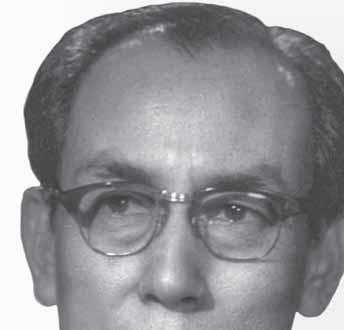
Burman got better and completed what turned out to be a musical masterpiece — the best in Bollywood history, according to a famous 2006 survey conducted by Outlook magazine which polled 30 high-profile lyricists, composers and singers.
And what glittering gems Guide offered!
Aaj phir jeene ki tamanna hai (an exuberant Lata song filmed

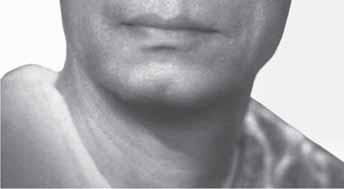
Over four decades (1935–1975), Burman composed music for more than 100 films in Hindi and Bengali and sang many wonderful songs himself. His longevity was remarkable. He was in demand till his death — unlike other maestros who aborted their careers because of either decline in fortune or changing times. He boosted the careers of numerous singers — including Geeta Dutt, Asha, Kishore, Manna Dey and Hemant Kumar.
What were the hallmarks of his music? It was youthful, ageless and reflected hope — one of a trea memorable ades (1 Burm mus tha Be ma son lon rem wa unlik tros w car d fortune or chan care ous — inc Dutt, Asha, Kishor d were t musi youthf an h

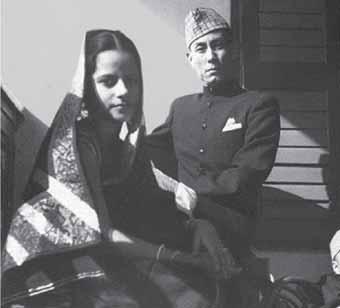

reason why it charmed Dev Anand. SD composed the transcendental Megha chhaye aadhi raat for Sharmilee at the age of 65 in 1971 — the year when his son RD Burman wowed listeners with Raina beeti jaaye in Amar Prem. It seemed as if father and son would become rivals!
Sweetness and simplicity suffused his songs. “I want to compose songs that even my servant can hum,” Burman used to say. It’s praise by commoners — workers, cobblers, van drivers, paan shopwallahs — that pleased him the most. No wonder SD developed an instinctive feel for the pulse of the people.


night, he would try it out before select audiences.”

Burman composed countless gems that have enchanted critics and laymen alike over the years. Here are a few glimpses into his oeuvre.
He was Bollywood’s prince of folk. Early in life, he roamed around rural Bengal, building a collection of folk tunes and music which proved valuable after he became a composer. “No composer entered the industry with such a rich stock of tunes,” said Dev Anand.
“His music captured the aroma of rain-sprinkled earth,” said Khagesh Burman, author of the book SD Burman: the world of his music
More than anything else, he personified perfectionism. Manna Dey said that just after he composed music for a song, “he would sing it from morning till

with Asha Bhosle.
Mera sundar sapna beet gaya — Geeta Dutt, 1947, Do Bhai. Melody laced with melancholy was never more magical than in this heartrending Burman song rendered by 15-year-old Geeta Roy (Dutt). It made her a superstar. Tadbeer se bigdi hui tadbeer bana le — Geeta Dutt. Baazi, 1952. A guitar-bearing Geeta Bali teases Dev Anand on screen. The seductive fastpaced number drove audiences crazy.
Thandi hawayen — Lata, Naujawan, 1950. A song that dramatised the intoxicating power of the Burman-Lata combo.
Yeh raat yeh Chandni phir kahan — Jaal, 1952. The song that made Hemant Kumar famous overnight.







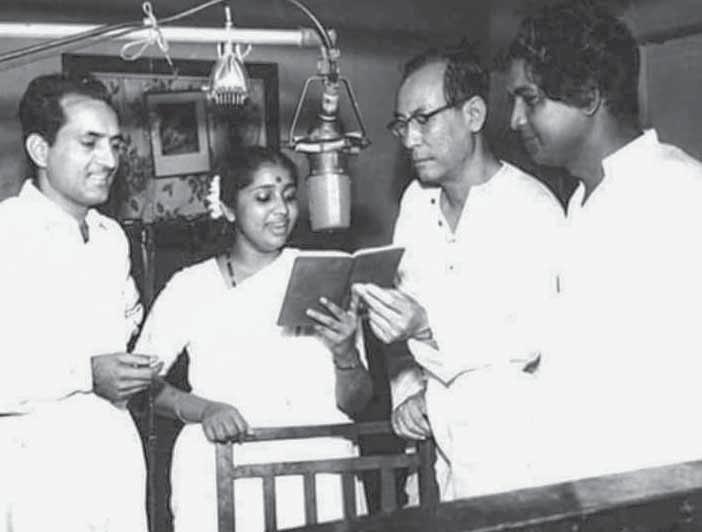
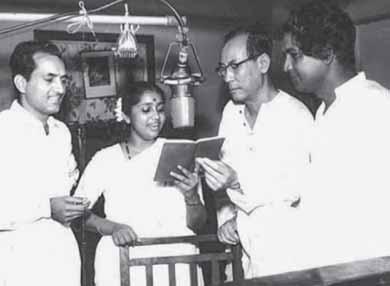


















Jeevan ke safar mein raahi — Kishore, Munimji, 1954. Singer Kishore and actor Dev had a flair for romance, tapped by Burman in this famous road song.
Yeh duniya agar mil bhi jaaye — Mohammad Rafi, Pyaasa, 1957. A writer’s thundering protest against injustice and exploitation. This Rafi song begins on a soft note and rises to a majestic crescendo. A triumph for Guru Dutt, Burman and Rafi.
Chand phir nikla — Lata, Paying Guest, 1957. This enchanting melody captures the plight of a young woman pining for her lover. SD, Lata and the lovely Sadhana give you a piece of immortality.
Ik ladki bheegi bhagee si — Kishore, Chalti Ka Naam Gadi, 1958. Burman’s score in this film astonished one and all with its witty, frothy melodies. This Kishore song aimed at Madhubala is a rollicking gem.
Waqt ne kiya — Geeta Dutt, Kaagaz ke Phool, 1959. An iconic song, dripping with pathos, from an iconic film, Geeta at her best.
Mere sapnon ki rani — Kishore, Aradhana, 1969.
Sharmila on a train serenaded by Rajesh Khanna in a car — a song and a film that revolutionised film music and catapulted Kishore to the top. Safal hogi teri aradhana — SD Burman, Aradhana, 1969. Burman used his own unique voice in the background
to deepen the mood or take the story forward in several of his films. This song won the national award for the best song.
Tere mere milan ki yeh raina — Lata and Kishore, Abhimaan, 1971, where music unites a young couple, draws

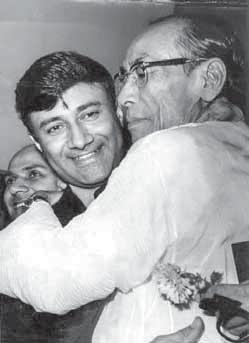
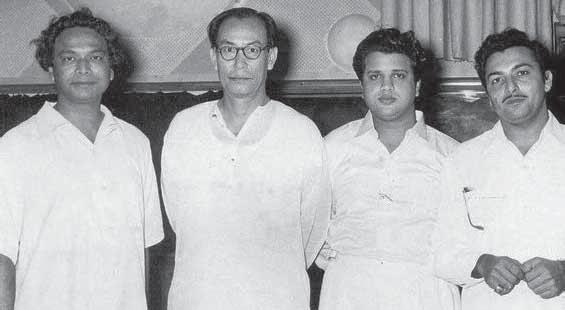
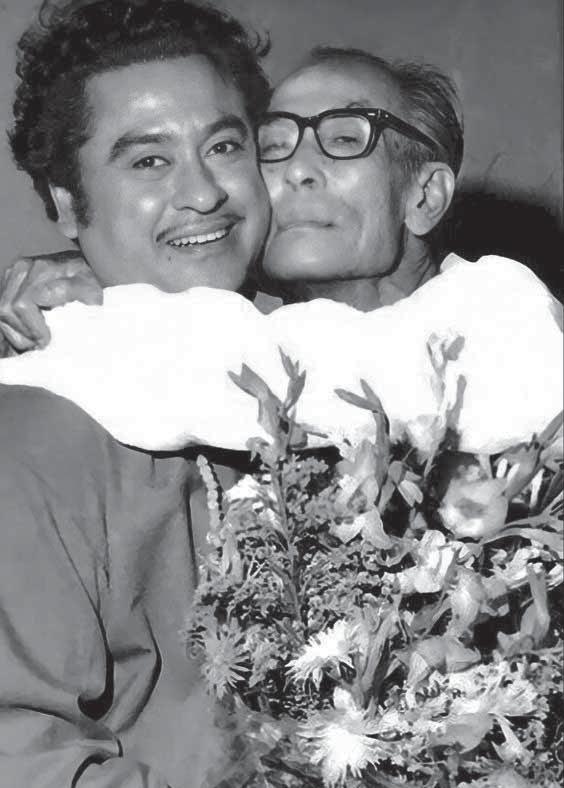
from top: SD Burman and RD Burman; with Kishore Kumar; Naushad, SD Burman, Jaikishan and Madan Mohan; with Dev Anand.
them apart and reunites them. One of the film’s many glorious songs. The film won him his second Filmfare award for best music, the first being for Taxi Driver.
Career outline
Burman was born in Comilla, now in Bangladesh in 1906, the youngest in a family with four sons and five daughters. His father belonged to the Tripura royal family, his mother was a princess of Manipur. The musician severed all ties with royalty after a few years. He learnt music formally from a number of gurus — the blind singer KC Dey, sarangi maestro Khalifa Badal Khan and sarod maestro Ustad Allauddin Khan.
His career began as a singer with All-India Radio in Calcutta, and as singer and composer in Bengali films. He moved to Bombay in 1944. His first major
success in Bombay was with Filmistan’s Do Bhai (1947) — the song Mera sundar sapna beet gaya of Geeta Roy (Dutt) became a rage.
Till his death in 1975, Burman composed some of Bollywood’s most memorable songs. Apart from songs for Dev Anand mentioned earlier, he composed superlative music for Guru Dutt — for the sombre masterpieces
Pyaasa (1957) and Kagaz Ke Phool (1959), a tour de force of existential angst. Chalti Ka Naam Gaadi (1958) for Kishore Kumar took the music world by storm with naughty, flighty and flirty songs. In 1959 came Sujata for Bimal Roy. Who can forget Kali ghata chhaye (Asha), Jalte hei jiske liye (Talat Mahmood) and Nanhi kali soney chali (Geeta Dutt), all tantalising melodies, from this movie?
Burman made waves in the 1960s with compelling
songs in Bandini (Ab ke baras bhej bhaiya ko babul-Asha, 1963), Guide (1965), Jewel Thief (1967) and several other films. Aradhana (1969) was a landmark of Hindi cinema. In Bandini, he hit the ball off the park with the haunting song, which he sung himself, Mere sajan hei us paar.
Despite failing health, he made unforgettable music during the 1970s in Sharmeelee (1971) and Abhimaan (1973). He slipped into a coma and died in 1975 at the age of 69.
Burman and Kishore Kumar Burman was very fond of Kishore Kumar. Both being a trifle eccentric, the account
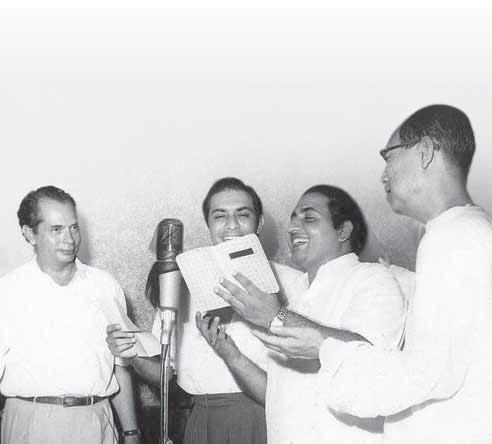









From L: Bimal Roy, Talat Mahmood, Mohammed Rafi and SD Burman during the recording session of the movie Devdas (1955).
















After the success of (1951), SD was very busy and decided to limit himself to three films a year. A producer who was very keen on SD visited him with a suitcase of currency notes. Said SD: “You may offer me as much money as you want, but my answer remains no.” The producer left, dejected. An eye-witness to the exchange remarked that SD ought to be more
with Lata Mangeshkar.
(Talat in , 1959), the most celebrated telephone song in Bollywood history, was inspired by SD’s own telephone song to a friend. The latter said he wished the song would never end.
“Lota” was Burman’s alltime favourite. “In sweetness and range, Lata’s voice is incomparable,” Burman said once. She sang 130 solos for him, compared to 44 by Geeta Dutt, 45 by Rafi, 52 by Kishore, and 75 by Asha. In 1958, Lata and Burman had a misunderstanding over the re-recording of a song for . They didn’t work together till 1962. Asha Bhosle was the biggest beneficiary of this rift. But once he and Lata were reconciled, Lata once again became his top singer.
Bengalis adored SD the singer but he didn’t enjoy much success as a music composer in Bengali films. Reason: audiences there loved his songs only if he sang them!
money-smart. He responded, “When you draw water from a well, you should do so with restraint or the well will dry up. This principle is true of music composition as well.”
In 1946, he was on a boat near Agartala. The boatman sang one of SD’s Bengali songs. When he realised that his customer was the song’s creator, he fell at Burman’s feet and said “What a voice you have, It seems as if a koel resides in your throat.”
SD was well-known for his white , his fondness for (he never shared his precious with anyone except occasionally with Lata when he was very pleased with a song recording), his craze for football (he was a fan of East Bengal and would grieve and even fast if East Bengal lost a match, particularly to traditional rivals Mohun Bagan), his quaint Hindi pronunciation of which he was totally un-selfconscious. He referred to Lata as “Lota”.
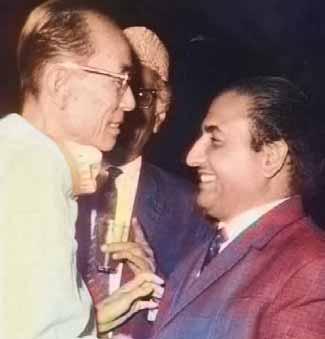
of their relationship is hilarious. One day his car encountered Kishore’s on a busy public road. Burman struck up a conversation and made Kishore repeat a new tune of his, despite blaring horns and screaming drivers and a protesting Kishore. But didn’t relent till the song was over.
On another occasion, Burman got into Kishore’s car
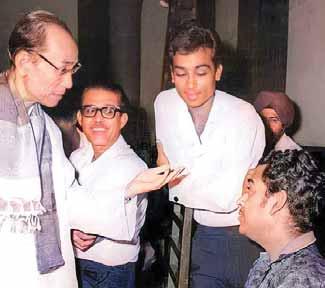
from his own, at a traffic signal on a busy road, and bade the driver go to the outskirts of the city. “Dada, I’m going for a sound recording,” Kishore said. “Postpone it. See, the weather is so good, let’s enjoy nature.” They reached some meadows on the outskirts of the city. Burman walked on the earthen boundary of the fields, started singing, then dancing, and
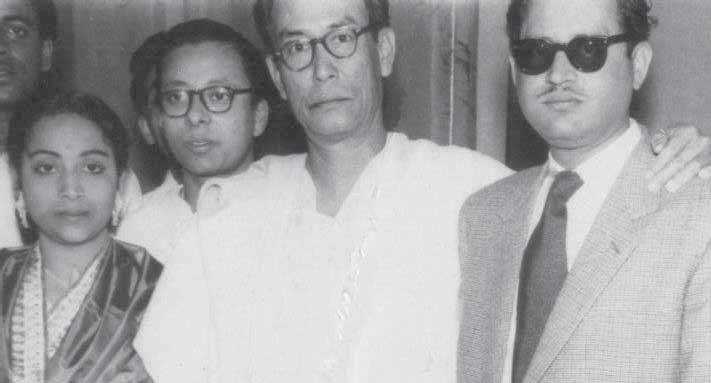
asked Kishore to join. “I was breathless but Dada was fine,” Kishore recalled.
In 1975 Burman was very ill. The doctor wanted him hospitalised, but he refused, saying he had to organise recording for a Kishore song in Mili. Kishore feigned a bad throat and told him, “You better go to hospital. By the time you return, I’ll be fine too and ready to record.”
But Burman didn’t return home. Kishore played a record of the Mili song for him on his hospital bed, which he approved of energetically. He passed away a few days later.
Burman may have renounced his Tripura royal legacy but he created an everlasting music legacy for millions of fans worldwide.
The author is a senior journalist and member of the Rotary Club of Madras South














Sandhya Rao
Books will take you anywhere and everywhere, at your leisure, for your pleasure. No need to catch a bus or train or even board a plane!
Fiction is the lie through which we tell the truth…’
This statement by the French (of Algerian birth) philosopher, writer, dramatist Albert Camus provokes. Think about it. Readers often ponder over what they read, why they read, how they read, and the train of thoughts that follow. Well-known people have commented on reading and libraries. In an article in The Marginalian, Maria Popova writes: ‘Galileo saw reading as “a way of having superhuman powers”. For Kafka, books were “the axe for the frozen sea within us”; Carl Sagan held them as “proof that humans are capable of working magic”; James Baldwin found in them “a way to change one’s destiny”; for Polish
Nobel laureate Wislawa Szymborska, they stood as “our ultimate frontier of freedom”.
Writer Neil Gaiman, in a lecture for The Reading Agency, pointed out: ‘Fiction can show you a different world. It can take you somewhere you’ve never been. Once you’ve visited other worlds, like those who ate fairy fruit, you can never be entirely content with the world that you grew up in. And discontent is a good thing: people can modify and improve their worlds, leave them better, leave them different, if they’re discontented.’
Two books I picked up recently, promise to show me completely different worlds that beckon alluringly and I cannot wait to peruse their pages. The first is a work of fiction, a book that popped up in a brimming-with-books store in Washington DC. Driving down Connecticut Avenue one day, en route to the zoo, I had noticed the name Politics and Prose against a green facade, and had even taken a picture of it. Some days later, we had the opportunity to stop by there — barely before it closed for the day. In those few minutes, though, my eyes flew over exciting, unfamiliar titles displayed on two tables, my hands lingered over a few and eventually picked up True Biz by Sara Novic.
What could the title mean?
There was an explanation on the back cover. It said the phrase was an adjective/exclamation in American sign language that meant ‘really, seriously, definitely, realtalk’. The novel, it said, ‘follows a year of seismic romantic, political and familial shifts for a
teacher and her students at a boarding school for the deaf.’
I have only just started reading the book. It opens with the description of a little girl in a classroom who stabs her ear with a sharpened pencil. While the children welcome the diversion, the teachers are more concerned about the child’s ‘family circumstances’. ‘Really, February explained to her father when he came to get her, she wasn’t upset at all, just tired of listening to the times tables, the buzz of the broken light above her desk, the screech of metal chairs against the floor. He didn’t know what it was like, having to hear things all the time, she told him. And with that he couldn’t argue.’
The day after purchasing the book, my husband and I took a trip to New Jersey where, one evening at a gathering, my cousin took me aside to meet a young woman he considered very special. He didn’t say anything more and when we met, she seemed that way: really bright, somehow special. Only later did he share the fact that she had been born hearing-impaired and that she had faced her challenges with courage and grace. Struck by the coincidence, I mentioned having picked up True Biz; my cousin immediately ran across and hailed down the car the young woman and her mother were leaving in and said to me, ‘Tell them. Tell them.’ So I told them about the book and that I had just started reading it and there had been a mention of cochlear implants and the young woman pointed to her ears and said, ‘Oh, I have a cochlear implant…’
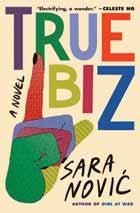

Serendipity?
I had only just found this book and now, not only was I reading a novel exploring the world of the deaf, but had also met someone who was from that world!
What can I say? Books take you places you never thought you’d be.
The other book, a work of nonfiction, carries an endorsement at the bottom of the cover, attributed to The New York Times, that says: ‘Rigorous and engaging… Languages, as this book makes clear, convey worlds.’ Another world this time, one recreated by Jing Tsu, a cultural historian of literature, culture, and science and technology. Called Kingdom of Characters, it talks about ‘the language revolution that made China modern’. What? you might ask. Again quoting from the back cover, Jing Tsu ‘argues that China’s most daunting challenge was a linguistic one: the century-long fight to make the formidable Chinese language accessible to the modern world of global trade and digital technology.’ In the book, Tsu ‘reveals how language is both a technology to be perfected and a subtle yet potent power to be exercised and expanded.’
We are familiar with Chinese, Korean, Persian calligraphy, and their importance in those cultures. But I was not aware that Chinese heads of state,
including Hua Guofeng, Hu Jintao and Xi Jinping, often brush-inked some characters or auspicious phrases at official occasions. It appears that Mao’s calligraphy is used on the masthead of the People’s Daily. As is observed in the introduction to the book, ‘…in the Chinese context, literacy means something more than just knowing how to read and write. It has traditionally signalled many things: the mark of being steeped in the classics and wisdom of the ancients; a meditative craft through which to cultivate a higher self; an elite medium through which to express one’s inner character, thoughts and emotions.’

subtleties that decoding it and transmitting through it posed a major challenge. What this book does is to look at China’s cultural universe, rooted as it is in its language and see how ‘from the grassroots to the highest level of the modern state, intellectuals, teachers, engineers, everyday citizens, eccentric inventors, duty-bound librarians, and language reformers embarked on one of the most extraordinary revolutions of the millennium in search of a solution.’
But this rich, ancient, sophisticated language made up of characters, strokes and tonal variations was such a complex web of cultural and linguistic




A solution to what? To make the language and its script ‘viable in a modern world increasingly transformed by various branches of Western science and new modes of electricity-powered communication, beginning with the telegraph.’
Two short quotes that preface the text are telling. One is by Lu Xun, referred to as the father of modern Chinese literature, who is quoted as saying in 1936 that, ‘If the Chinese script does not go, China will certainly perish.’ This gives a fair indication of the enormity of the task of ‘simplifying’ the language. The other is by Chen Mingyuan who is a linguist, a poet, a mathematician and computer scientist, among much else. He is quoted as saying, in 1980, that ‘computers are finally able to process Chinese! Long live square characters!’
The prospect of sitting down to read True Biz and Kingdom of Characters is filled with the promise of making new discoveries, and of taking ideas to the edge to make things work. Such a feast lies ahead! A feast I hope will stir up discontent.
The columnist is a children’s writer and senior journalist
Bharat and Shalan Savur
Honestly, I never thought teeth were so important for our health. They appear so hardy, feel so tough and strong – especially when they accidentally bite your tongue! But the fact is: they are vulnerable as they inhabit our mouth which is a wild, walk-in world for unfriendly bacteria to linger, flourish and create havoc. Really? you might ask. Yes. If we don’t observe oral hygiene, not only can our teeth be toppled, we can wake up at midnight to excruciating pain, and even if we apply an antibiotic cream or pop a strong painkiller, our sleep cycle is disrupted, we slumber uneasily and wake up fatigued.
This happens due to inflamed gums. And inflammation is our blood vessels switching from state-of-theart being to a state-of-war response to unfriendly bacteria and food particles, both of which should not be there in the first place. This inflammation, though in the gums, causes a stress-response even in the cardiovascular system. The heart pumps faster and the adrenaline glands secrete adrenalin.
Even our mind can get adversely affected. Gum disease can lead to low self-esteem, bring on bouts of anxiety or depression and, in this scenario, self-confidence ebbs. It’s a gradual process where you can lose interest in food and become indifferent to your surroundings.
So don’t allow yourself to reach even halfway to this sad stage. Give your teeth and gums the attention and care they deserve. You might have heard the joke: At what time do people go to the dentist? At tooth-hurty. Don’t neglect your teeth, get started on lovely
little rewarding practices that relax you as your mouth becomes healthier and you get back your mojo. Here’s how: Never sleep without brushing your teeth. Brush in circular motions patiently for a full two minutes. Be aware that you are ridding yourself of germs and plaque, and preventing gum disease. Brush your tongue too. Or use the arced tonguecleaner available at the pharmacy. Choose to use a fluoride toothpaste. Whitening powers and flavours are not important, fluoride is. It kills germs and prevents cavities. Floss out food particles from between the teeth. Bonus: it stimulates gums, reduces plaque, helps lower inflammation. Rinse after every meal. You’ve had a good meal. Now, take a mouthful of water, swish vigorously and spit it out explosively. Flush out the slivers and tiny spices from the hidden crevices and gaps. Limit sugar, acidic foods and beverages. Sugar interacts with the plaque’s bacteria to produce acid. Acid erodes the enamel. Drink water to dilute the acids. Quit smoking. Smoking delays the natural
tissue healing process in the mouth and invites infection. In sum: no tobacco, no gum disease. For strong teeth, eat super foods. End meals with milk, yoghurt or cheese. They contain calcium and phosphates which re-mineralise the teeth and help build enamel. Eat crunchy food with a glass of water. They stimulate saliva, scrub the teeth clean and the water carries away plaque, particles, bacteria. Crunchy foods include carrots, apples, pears, nuts like almonds, cashews, walnuts, peanuts. If you enjoy fish, go for salmon. It’s loaded with phosphorus that protects tooth enamel. Also, black tea,

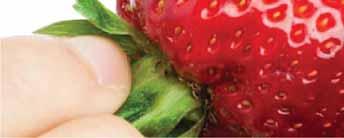

green tea and coffee are friends of teeth — rich in polyphenols and antioxidants, they prevent cell-damage, reduce inflammation and help fight cancer. Finally, make sure you add strawberries to your diet. They contain vitamin C, antioxidants and malic acid which can even whiten the teeth a bit. Incidentally, don’t lose sleep over yellow teeth. It’s natural — some teeth are white, some yellow — like different skin colours.
Consult a dentist for any discomfort in the mouth. This is important because if there is any rot, any infection, every time you swallow, unfriendly bacteria goes in. That’s bad news. Experts say this harmful bacteria travel into the bloodstream and lungs. Please don’t give them a chance. An example: You may be chewing food from only one side because the other side hurts. It’s like


hopping around on one leg because the other is stiff. It’s simpler to consult a dentist than to feel out of whack. It may not need surgery. You could be advised to brush your teeth with a toothpaste like Thermoseal or Sensodyne because you have sensitive teeth that can’t bear hot or cold food and beverages. You could be asked to apply the de-sensitising toothpaste with your finger on the sensitive spots and keep it there for 10 minutes — this stops the pain and smooths serrated edges as it builds tooth enamel. Or a cavity may need to be filled.
If the tooth has ‘advanced’ beyond sensitivity, you could be advised the root canal treatment. I can describe it as I recently went through one. It is done neatly, hygienically and painlessly.
The dentist dabs numbing medication on the gum near the over-sensitive tooth. When numbed, he injects a local anesthetic into the gums. Then he makes a tiny opening in the tooth-top to expose the infected pulp, removes it with dental files and cleans the canals. He coats the area with a topical antibiotic and puts a temporary filling to prevent re-infection. After a few days, he puts a more permanent filling. And finally, the dentist may cap the tooth with a permanent crown. Voila! The infected tooth is cleaned, repaired, restored, healed.
One of my teeth was far too gone and not worth saving by the root canal treatment, so we opted for extraction. Due to medical advances, even that was painless. Yes, I confess I was nervous. But my sister, a family physician and psychiatrist told me, ‘Smile through it and you’ll sail through it.’ I did.
Don’t grind, don’t gnash
One more important fact not to be ignored is how stress affects your teeth. Haven’t you noticed how you
clench your jaw when angry? And if you often wake up in the morning with a headache or feeling unrested and tired, it could be because you’ve been gnashing and grinding your teeth all night. How do you stop it? The obvious answer is: Reduce stress in your daily life. If you can change tension-causing circumstances, change them. If not, attend Yoga classes. Here, through meditation, talks, you get a wider perspective; and the asanas drain tension and relax your body. Sleep to Yoga Nidra meditation or soothing music. Take a warm bath. Avoid stimulating stuff — TV news, social media rants, caffeine, cigarettes, arguments, alcohol — in the evenings.
You could also check with your dentist if you have jaw pain, difficulty in chewing, clicking in the jaw joints, pain around the ear-area. It could be TMJ-related. TMJ — TemporoMandibular Joint — links your jaw to your skull. Thanks to this joint, we can move our jaw up and down, side to side, talk, laugh, chew, yawn. When we grind our teeth, the pain spreads from the jaw muscles to the skull causing a headache. The dentist won’t prescribe a medicine or procedure of any kind. All that is needed is a night-guard. It is designed to keep the upper and lower teeth separate. A soft night-guard is available at the pharmacy. Or the dentist can have a custom-made one of thin plastic to fit over your upper and lower teeth. I suggest, go for the custom-made one. When worn while asleep, it stabilises and relaxes the jaw. And the teeth can’t grind. Someone described it as ‘spectacles for the teeth.’ There’s only one requirement for it — keep it as squeaky clean as your teeth. Remember, the tooth-fairy does not visit adults!
The writers are authors of Fitness for Life and Simply Spiritual – You Are Naturally Divine and teachers of the Fitness for Life programme
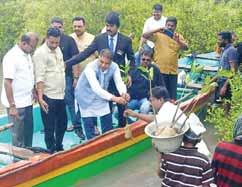
DG Selvanathan participated in the club’s mangrove plantation drive in a coastal area at Mallipattinam village.
Shree Gandhi Inter College in Ghori Bachhera village was renovated with a CSR grant of `24.3 lakh from KEI Industries.
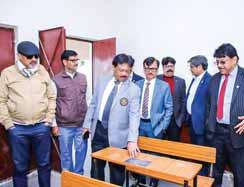

The club is conducting spoken English classes for school students. State school education minister Mahesh Poyyamozhi distributed course completion certificates to students in a school.
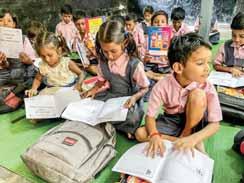
Project Read with me is an ongoing initiative to develop the reading and writing skills of children from low-income families. Study materials are given to the children.
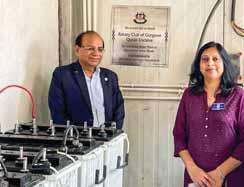
With CSR funding, four solar plants and 39 solar lights were installed at different facilities.
A breast cancer screening camp was conducted by club member Dr Mukesh Bavishi for 225 Jain nuns.Club president Vidula Bavishi aims to cover all the sadvis by the year-end.
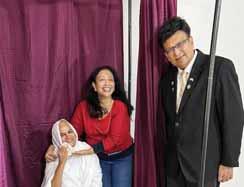
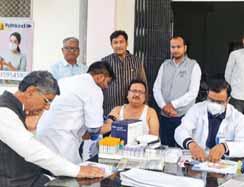
Over 70 patients were checked for BP and blood sugar at a medical camp held in partnership with Pathkind Lab. Consultations on healthy life were given.
Science lab materials and benches were donated to Mamasaheb Mohol Vidyalaya, Warje, under the Happy Schools project.
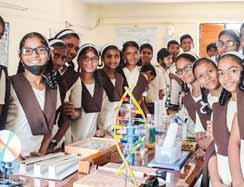
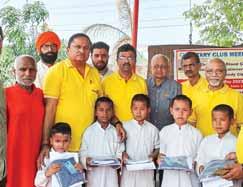
Stationery and uniforms were distributed to children at the Vedic Ashram and KS Public School, Sisoli, in partnership with the Nutema Hospital and Kalyani Path Lab.
At a dental check-up camp, 120 people were screened at Kotnis Sabhagruh with the support of Koyna Vasahat Panchayat in Karad.
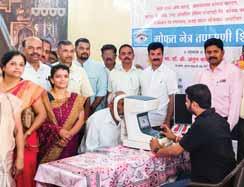

Artificial limbs and callipers were distributed to 220 amputees at a two-day camp held with the support of doctors from the Narayan Seva Sansthan, Udaipur.
DG Kailash Jethani inaugurated a diagnostic centre at the DPO’s Nett College of Physiotherapy. It will be managed by Jeevan Rekha Diagnostic.
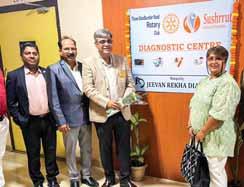
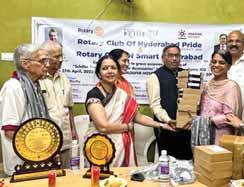
In a joint project with RCs Hyderabad Pride, Jaisalmer Swarn Nagari and a free mason club, neonatal devices (`1 lakh) were given to Nilofer Hospital.
Spectacles were distributed to 190 students from the government primary and high schools. The project was done in memory of late Rtn PR Naveen.
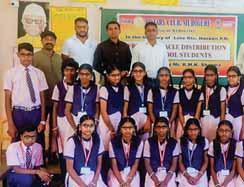
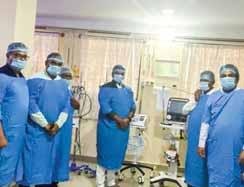
Neonatal equipment were provided to the Government Women and Children’s Hospital. RCs Chitradurga, Chitradurga Fort, Gulbarga and Nadyal, and RID 3150, besides global districts, were GG partners.
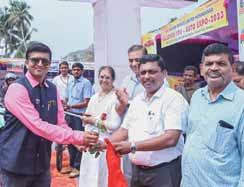
Over 5,000 people visited the two-day Auto Expo 2023, a fundraiser for e-Pathsala project.
Medical devices (`25 lakh) were donated to the Karnataka Institute of Endocrinology and Research for diabetic management. Also, insulin (`10 lakh) for 30 diabetic children is being sponsored for a year.
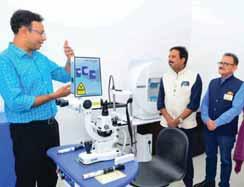
A handwash station and RO unit were inaugurated at the Government Model Girls High School. The WinS projects is benefitting 25,000 students in 15 schools.

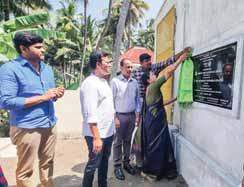
Two toilet blocks worth `9 lakh were built at the Government High School, Gollapatti, to ensure clean hygiene and sanitation for students.
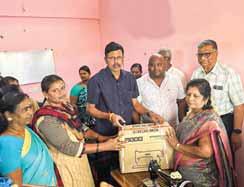
Tailoring machines were distributed, with the support of Inner Wheel Club of Nanganallur, to 33 candidates who passed out of a training course at the vocational centre.

Bicycles were donated to an orphanage which accommodates 16 girls. This gesture will help them to commute easily and take care of themselves better.
Menstrual cups were distributed to 200 Rotaractors and students of Lal Bahadur Shastri Memorial College, Jamshedpur.
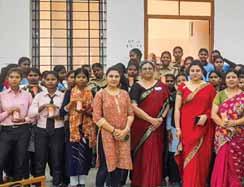
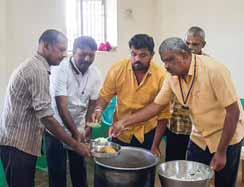
Club president Ibrahim and member Senthil sponsored lunch for the 40 mentallychallenged people at the Deva special home in Moondradaippu village.
A thalassaemia awareness campaign was launched with former cricketer Sunil Gavaskar and santoor maestro Tarun Bhattarcharya as ambassadors.

Compiled by V Muthukumaran
Snobbery comes in many forms. It can be because someone feels superior because he or she comes from a particular social background or a branded school, college, university and profession. Or it can be because you feel superior to those who can’t speak English or, even if they can, their accent is different. It can be because you happen to hold particular political views. Or because you wear certain fabrics. Or because you drink only certain whiskies and eat only salmon. And often because of where you live.
There are many institutions that encourage snobbery. A ‘St’ something as the name of your school and college is still preferred. One well-known British university is a terrible offender in this regard. It has four castes: undergraduates, post-graduates, doctoral candidates and foreigners. And this is in the descending order. I was astonished to hear this. They said we don’t know where the last three come from but undergraduates, we choose them, they are the crème de la crème. The worst, of course, are people like me who combine all of these things, except maybe one or two. But I make no bones about it: I am a snob who feels others should be grateful if I allow them to befriend me. I reserve this attitude, however, only for men. So imagine my chagrin when the other day I not only met an even bigger snob
than me but also two women who had been in my class in college who said I had been insufferable in those days. It dented my self-image.
The fellow who was an even bigger snob than I sniggered when I told him I lived in Gurgaon which is adjacent to Delhi but in Haryana. “Oh, the suburbs,” he said. His meaning was clear: you didn’t count if you didn’t live in Delhi. He then asked me about my “dwelling unit”. I said you first, tell me about yours. It turned out he lived in a very posh but very crowded area in a very tiny flat in a low-rise building. I told him I lived in a three-storey house with a large garden in a compound that resembled a forest. But I don’t think

he cared about all that. A 1,200 square foot flat with a carpet area of 1,000 in South Delhi was his idea of social superiority even if you couldn’t park a cycle anywhere. When I told my wife this, she said I was exactly like that because of my background, education and job. “You are poor as a church mouse but a snob nonetheless.” Cruel woman… but, as the Bard wrote in his play, “an ill-fav’d thing, my Lord, but mine own.”
As to the two classmates, their grievance was that I didn’t talk to them back then. But I know the truth. It wasn’t snobbery, it was just plain old shyness. And also, I must admit, an absolute lack of interest in what the girls had to say. To date, I have no idea what teenage girls talked about. So bored by them yes; snob never. Not with girls.
I am a snob who feels others should be grateful if I allow them to befriend me. I reserve this attitude, however, only for men.
Since then, I have thought long and deep about snobbery. Is there a descending order of things that grades your snobbery? How many attributes must you have to be a complete snob? And how do you tell if a snob is just pretending, you know, faking it like those chaps who serve cheap alcohol in costly discarded bottles? Is class more important than caste? Why doesn’t a person’s religion induce snobbery? Skin colour, of course, is a sure-fire inducer of superiority and inferiority. And so on. There are so many questions, so few answers.
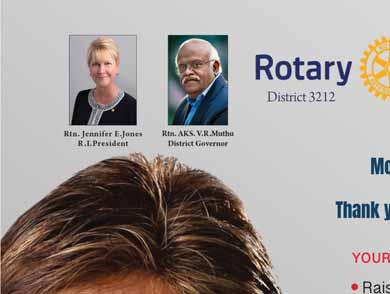
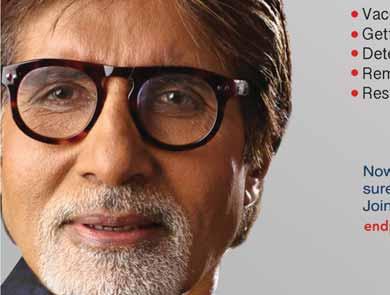
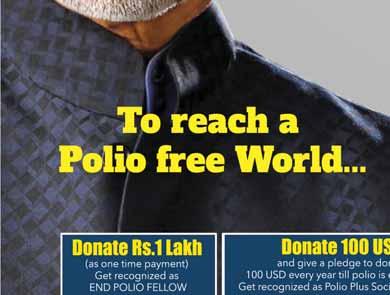
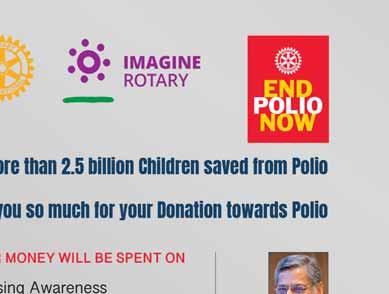
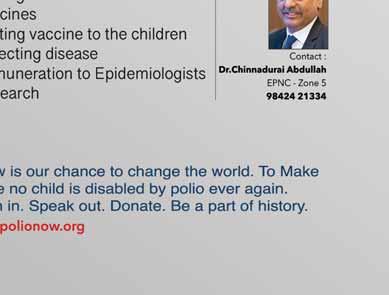


Registered No. TN/CCN/360/2021-2023
Licensed to post WPP No.TN/PMG(CCR)/WPP 431/21-23
Total number of pages in this monthly issue, including cover, 84. Price: `40
Regd with RNI 3880/57. Rotary News Published 1st week of every month. Posted at Egmore RMS Patrika Channel. Date of posting: 4–10 every month.
